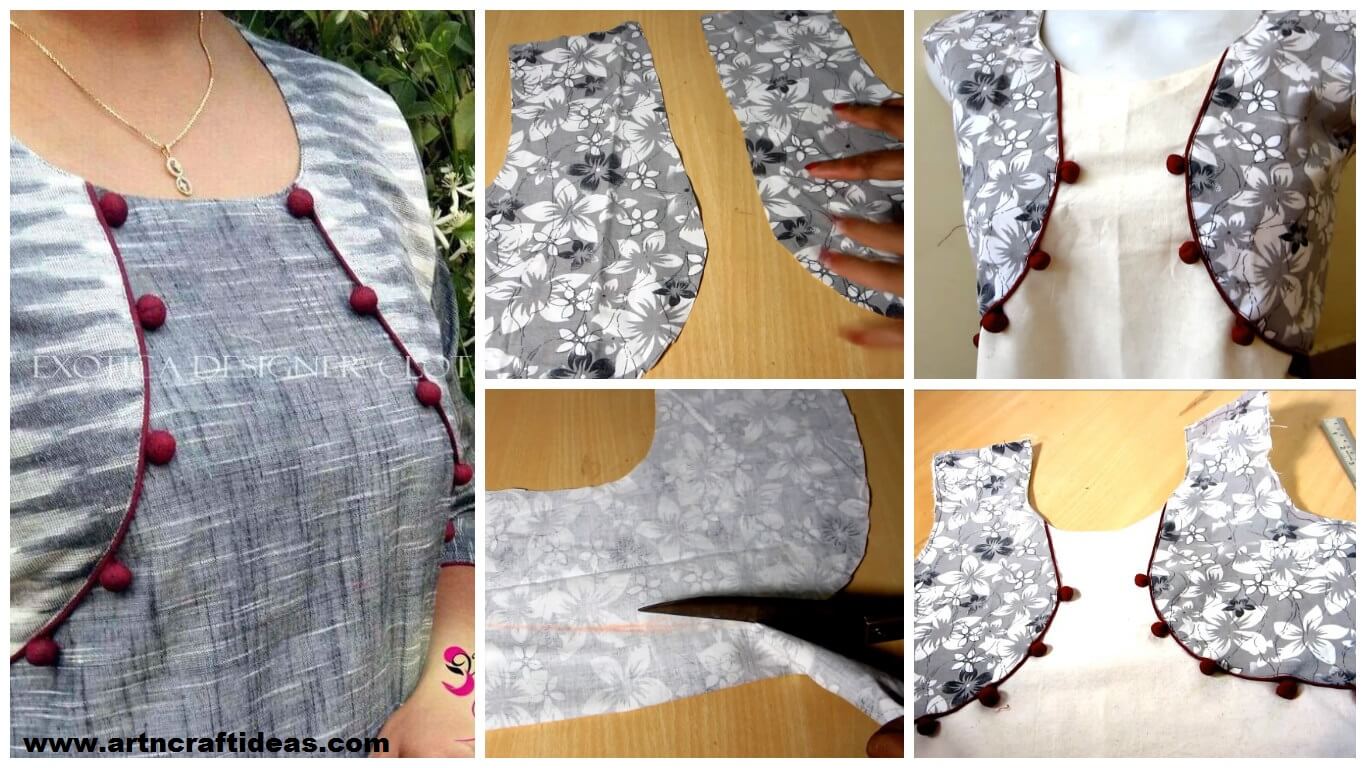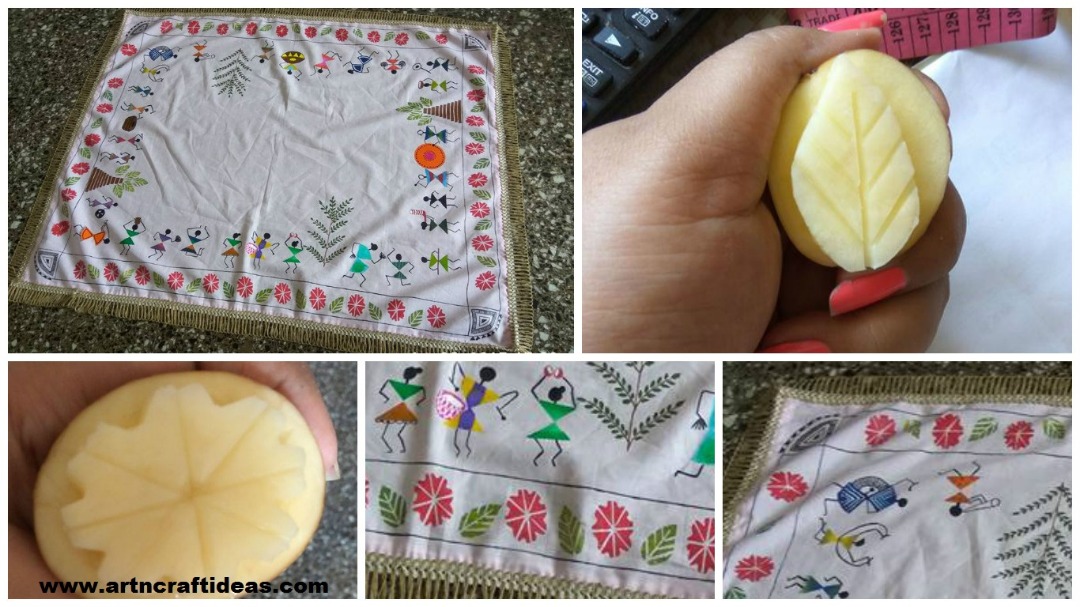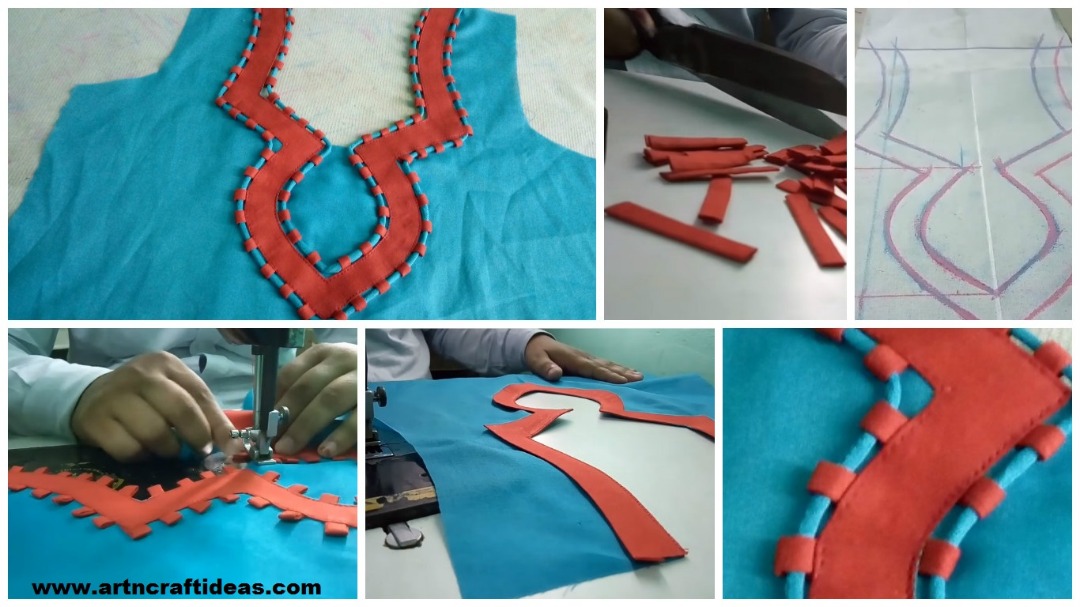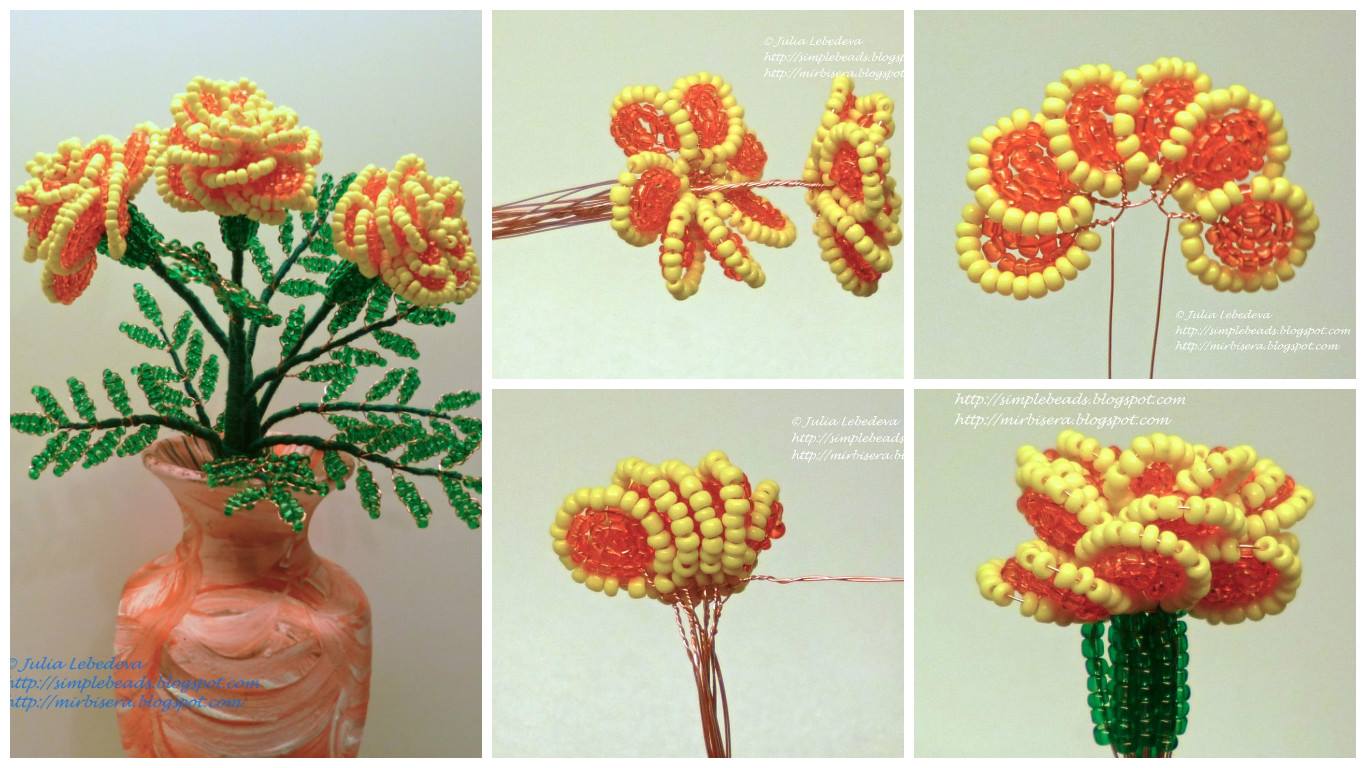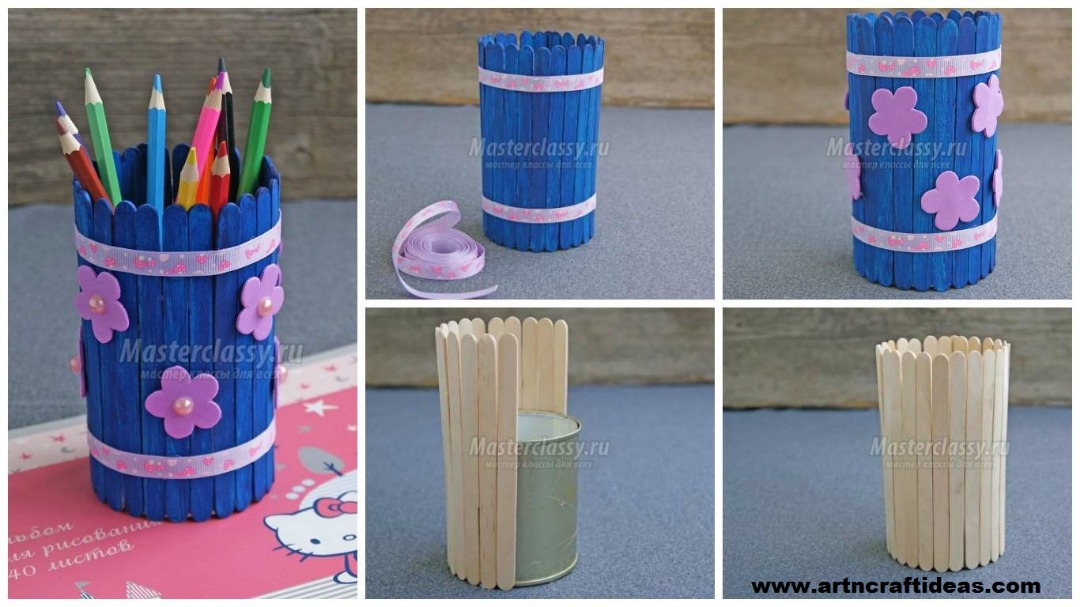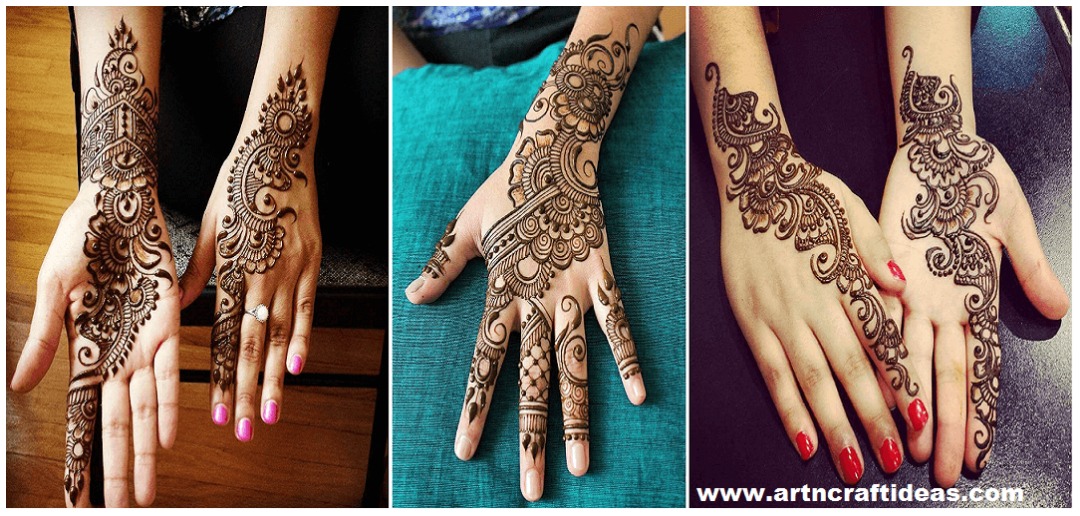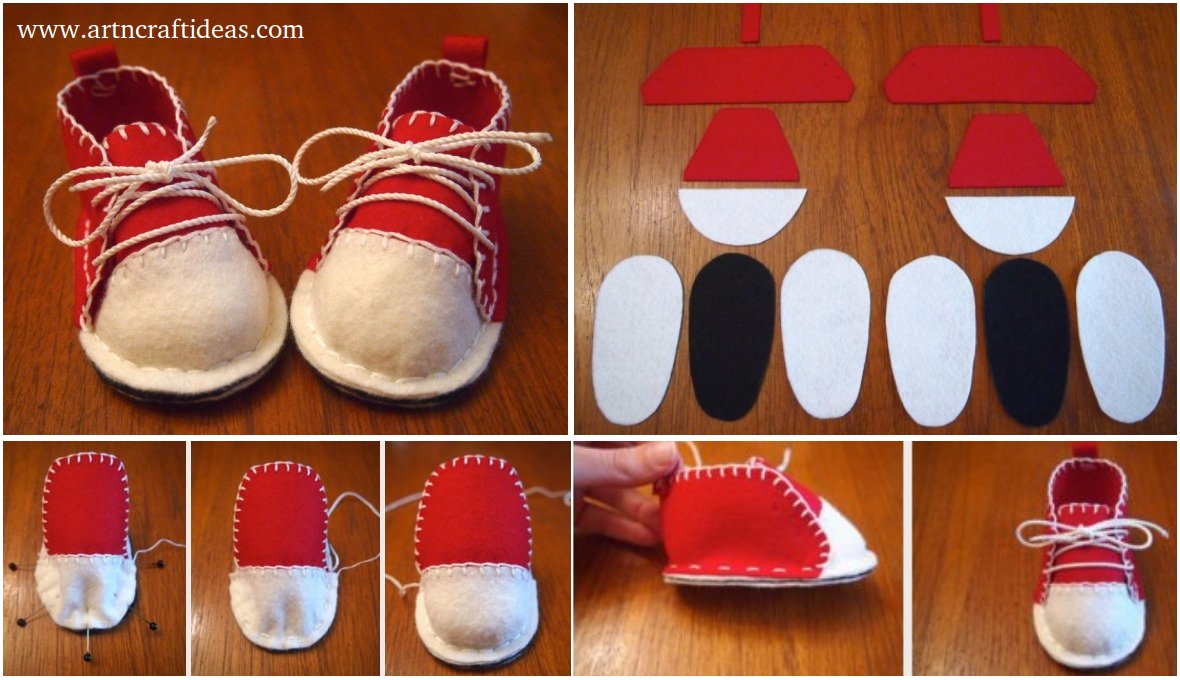In this video, I will show you how to make Jacket style Pattern Kurti | Kameez Cutting & Stitching | DIY in the simple and easy method.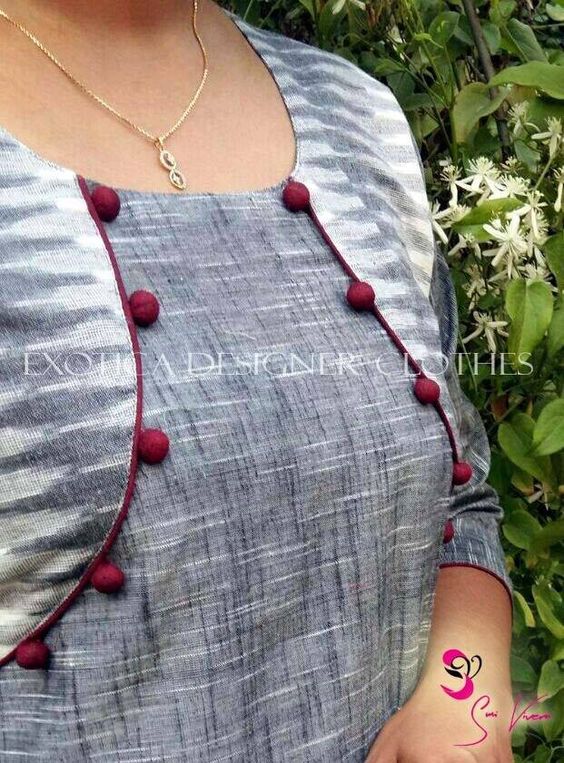
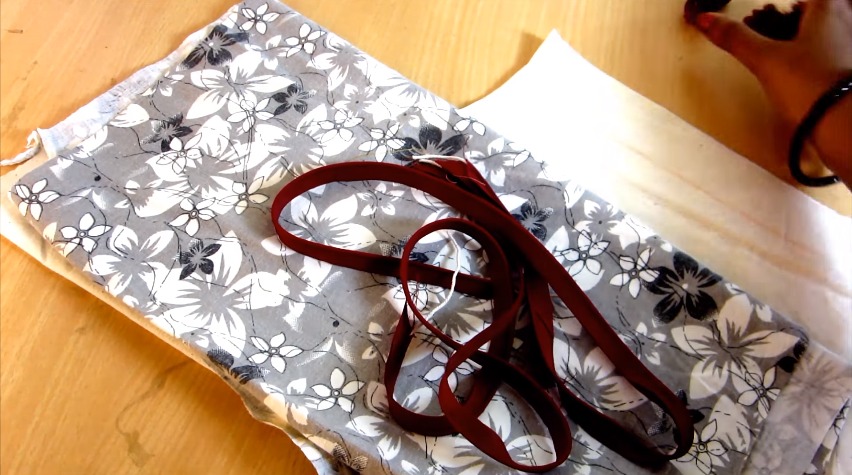
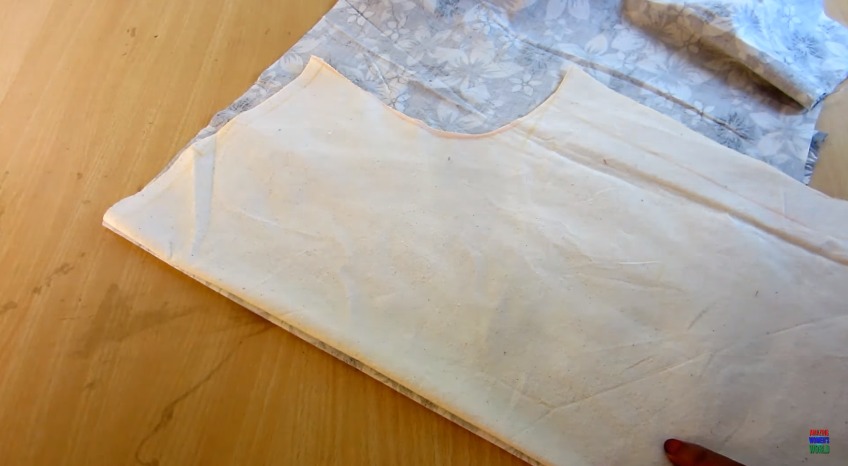
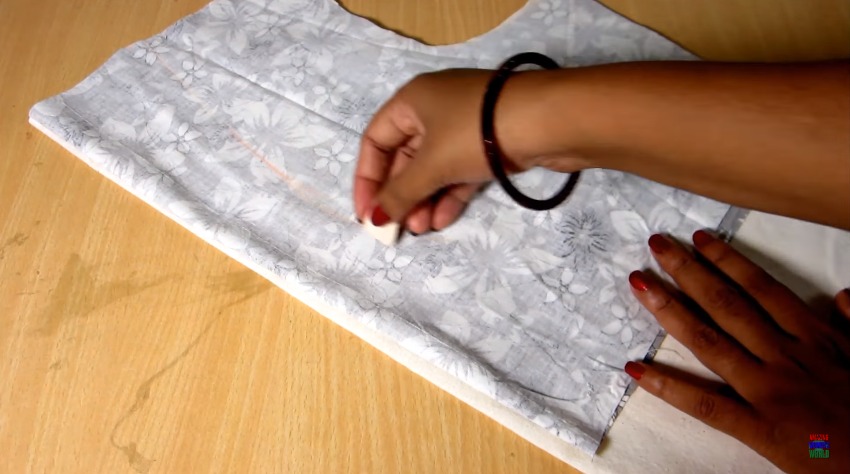
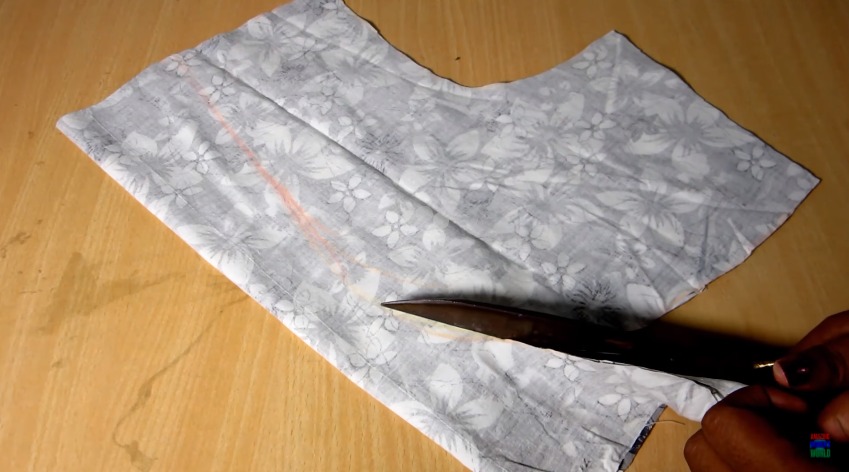
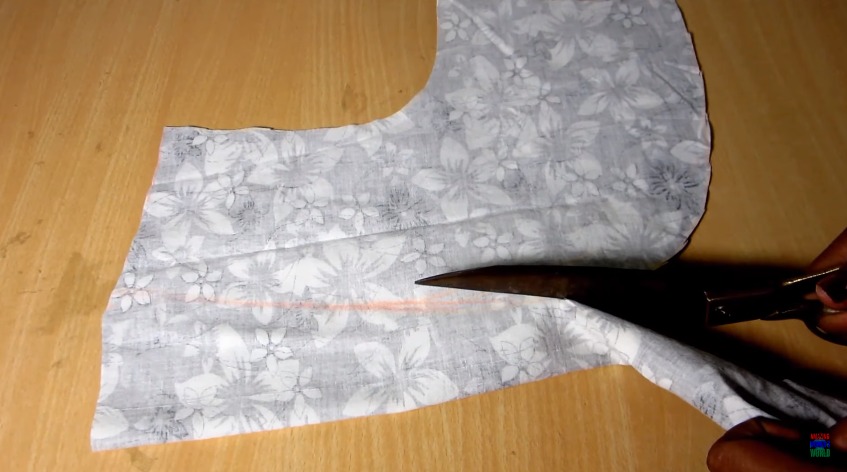

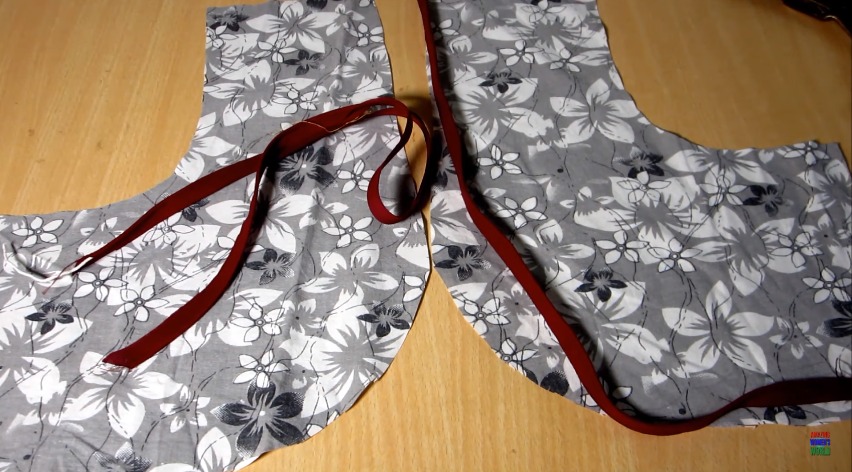


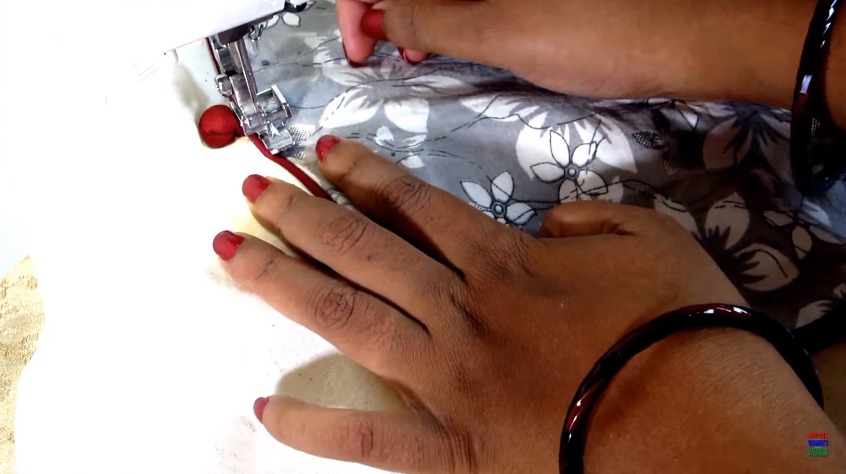
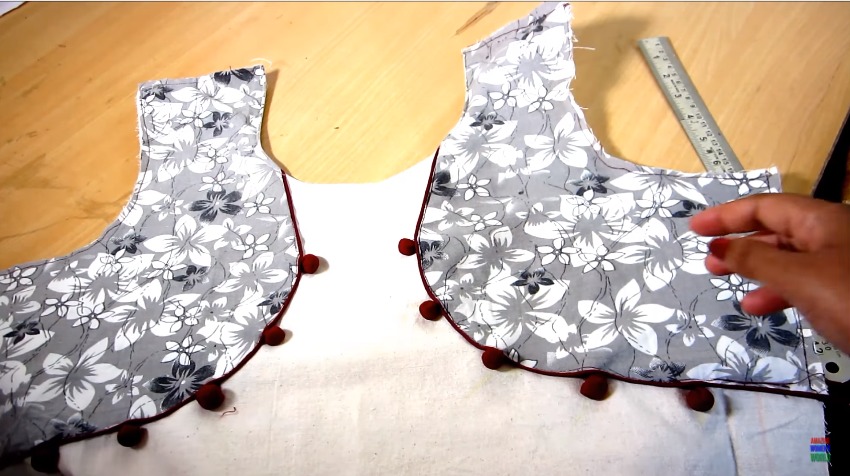

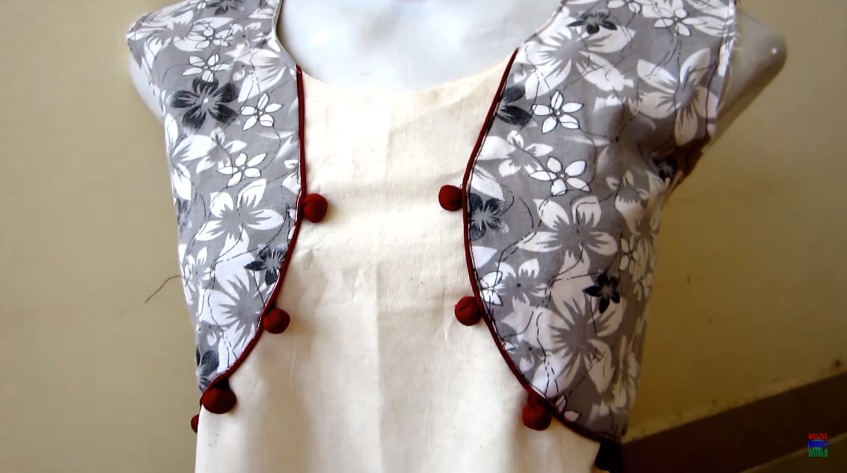
15+ Different Types of Sleeves Designs
Sleeves are such an important part of clothes as it is one of the first things you see in a garment. They should fit properly and be comfortable to wear as well. Sleeve styles vary greatly with time and fashion.
Fashions of sleeves come and go. One moment a particular sleeve may be in fashion but then they disappear completely for decades to resurface later and become a rage again. I remember wearing loose puff sleeves in my teenage years as it was in fashion; now I cannot imagine wearing them, one because it absolutely kills my body shape and two they are luckily not in fashion.


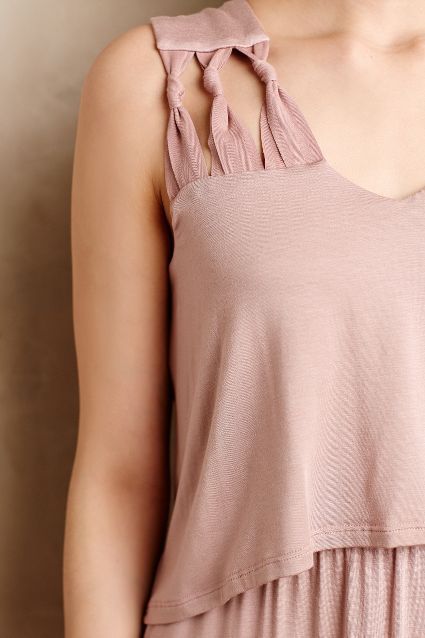

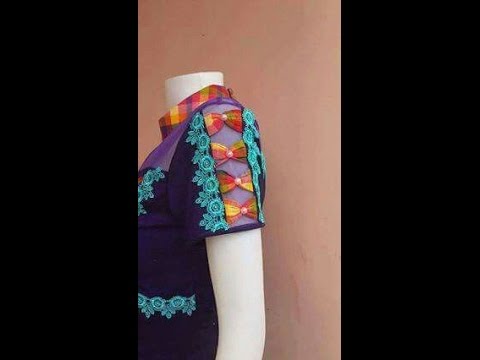

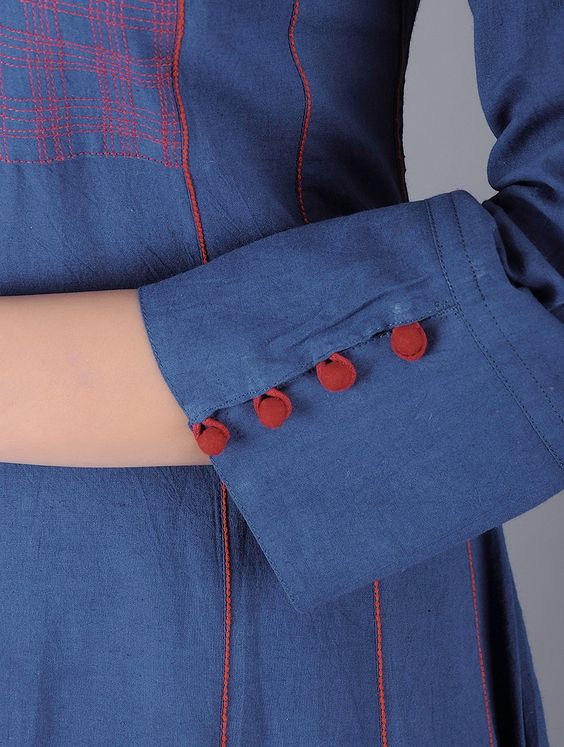
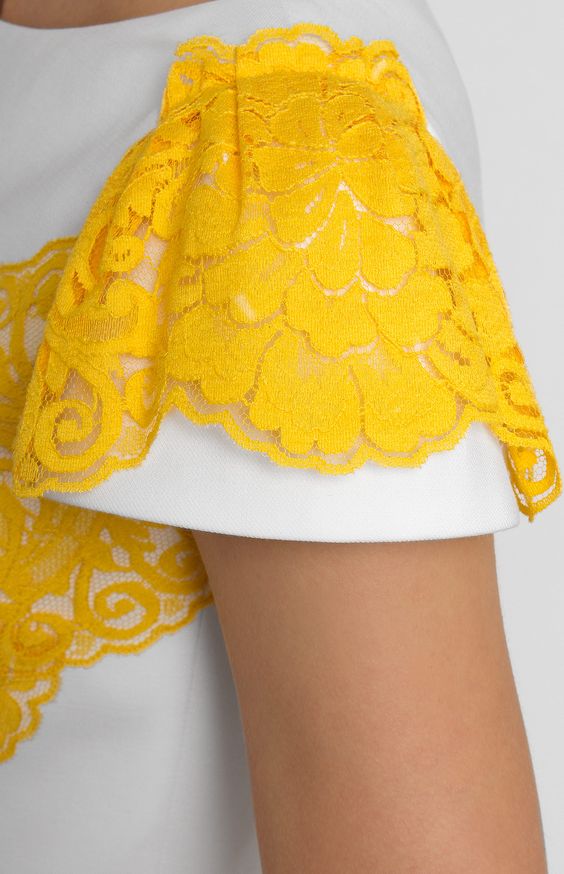

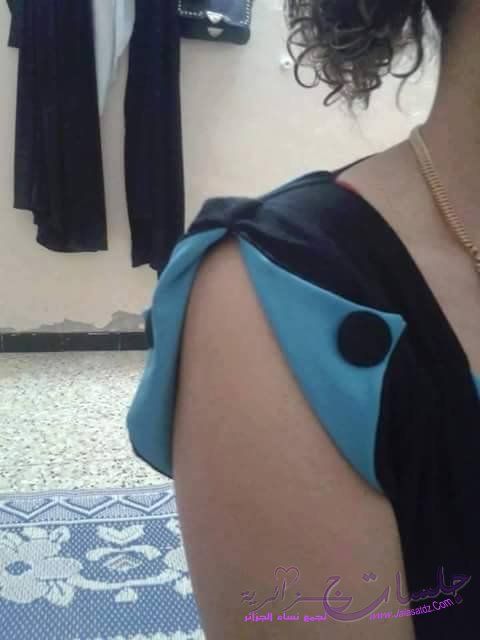
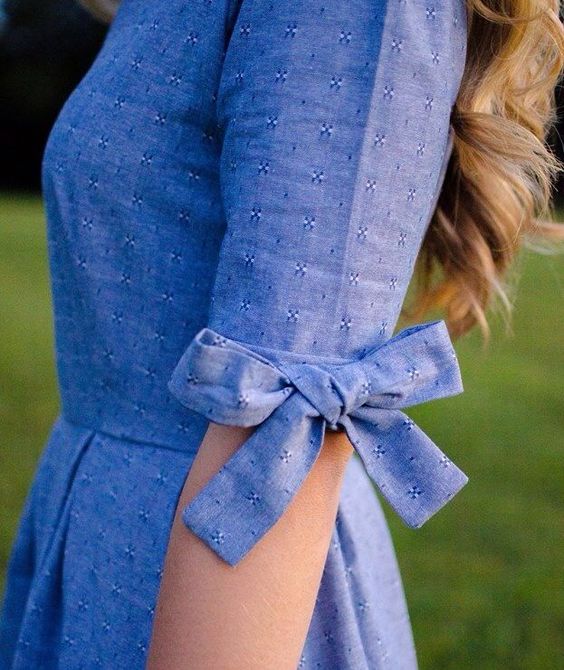
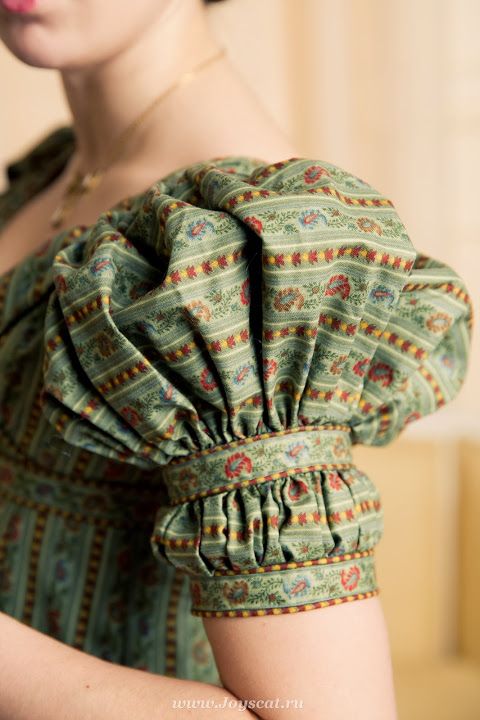
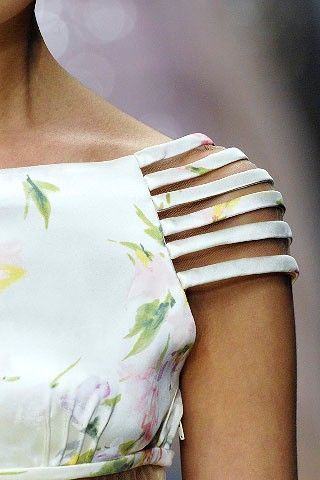
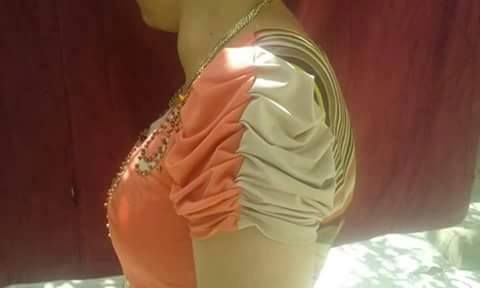
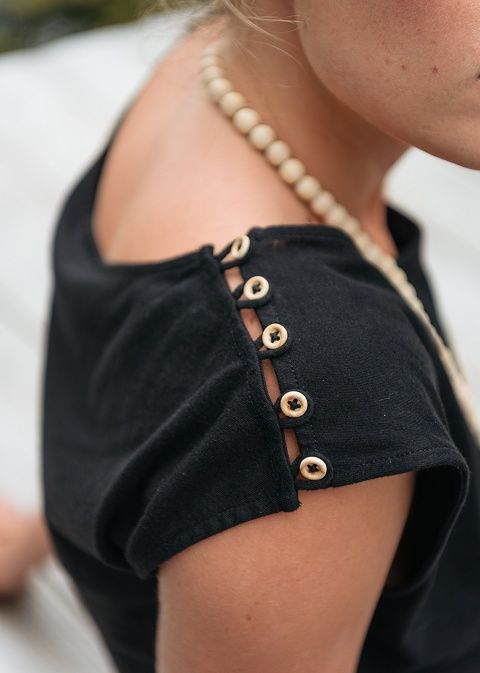
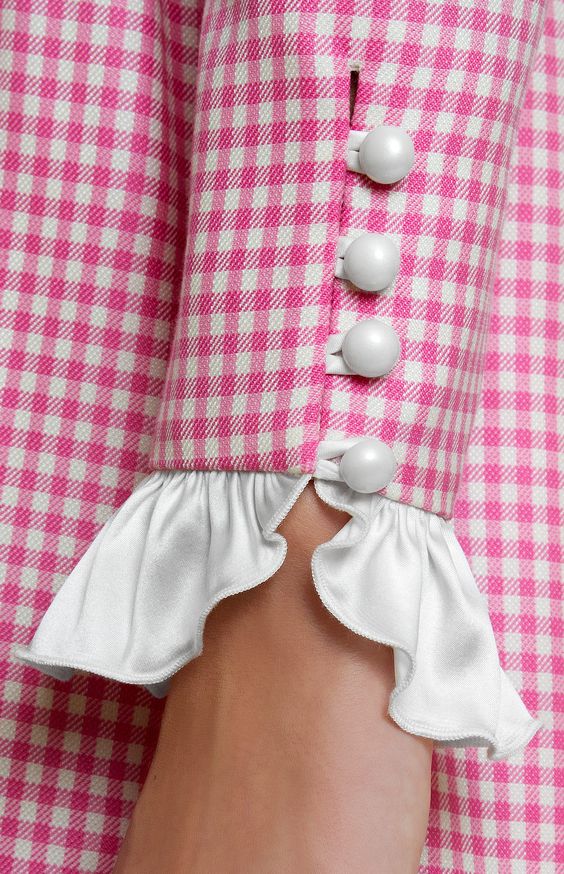
DIY warli art table cover using potato stamps
Table cover warli art using potato (carving) stamp/print, the even warli body is done by potato. Here is an amazing tutorial by Tamanna Lalwani for Warli art on plain white cloth.
(A concept similar to block printing.)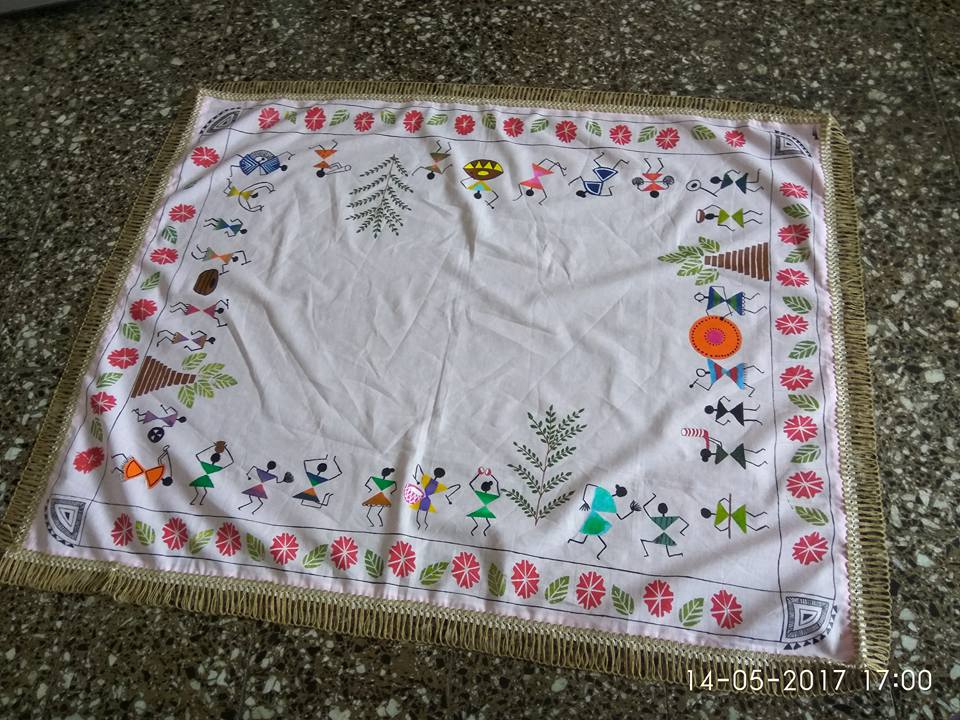
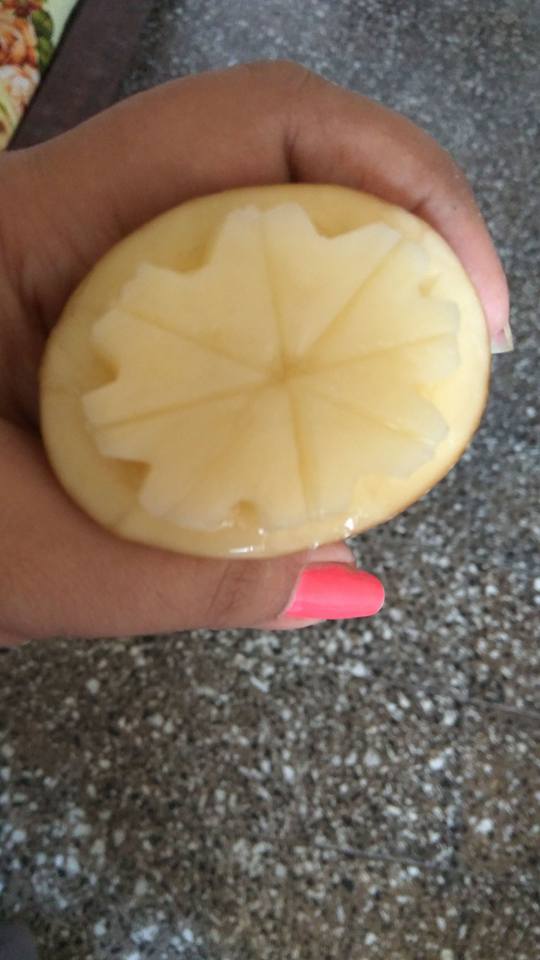
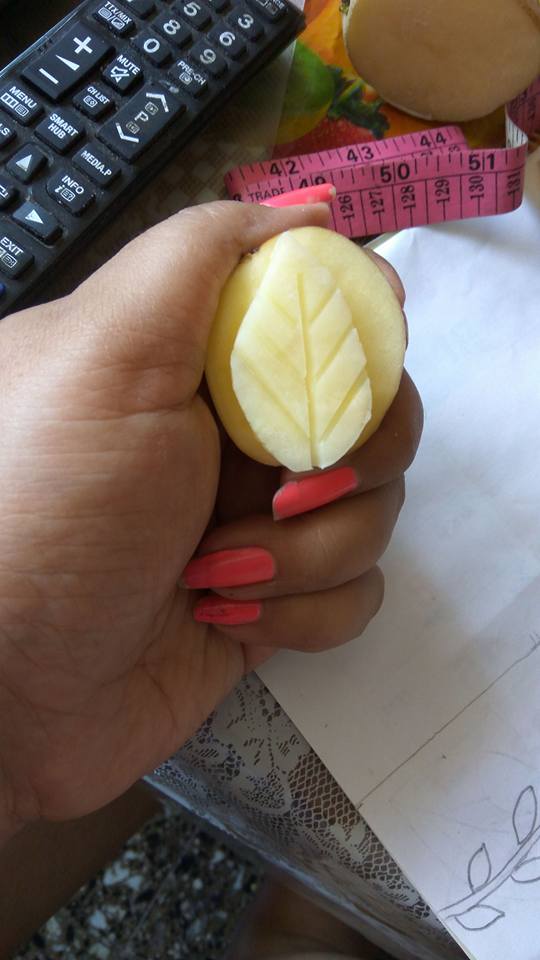

Image Source: Facebook
How to sew piping neck design
This is a unique neck design this neck design can use in kurti,suit and ladies kameez.
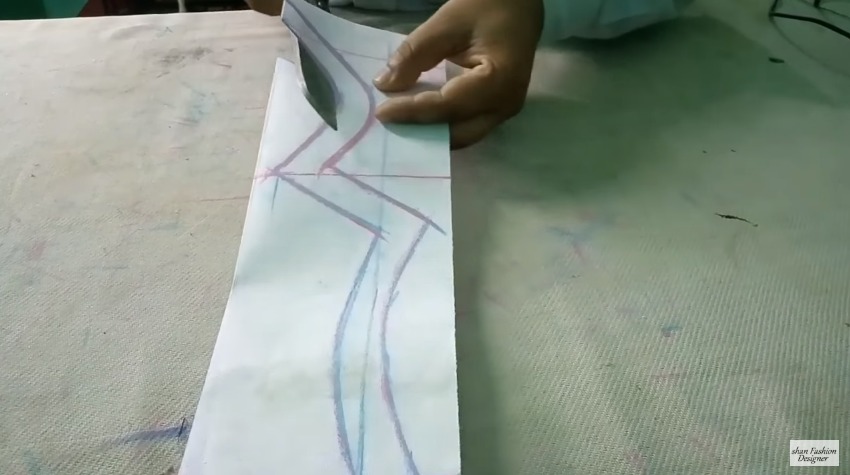





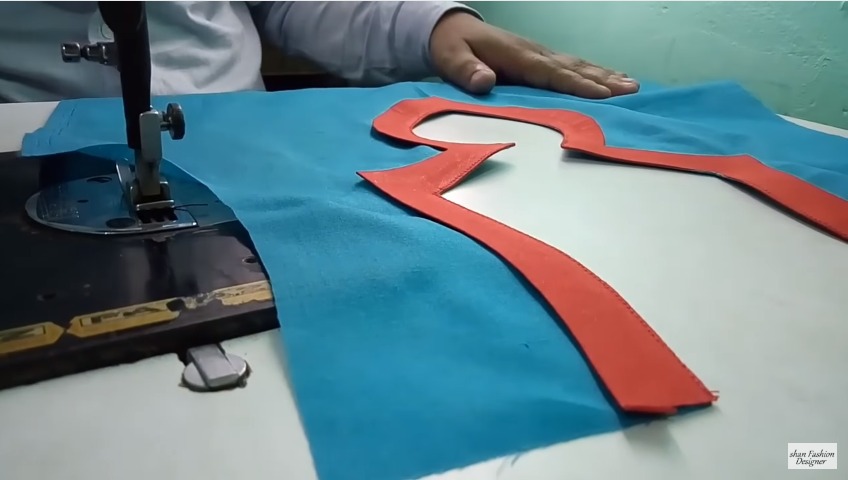
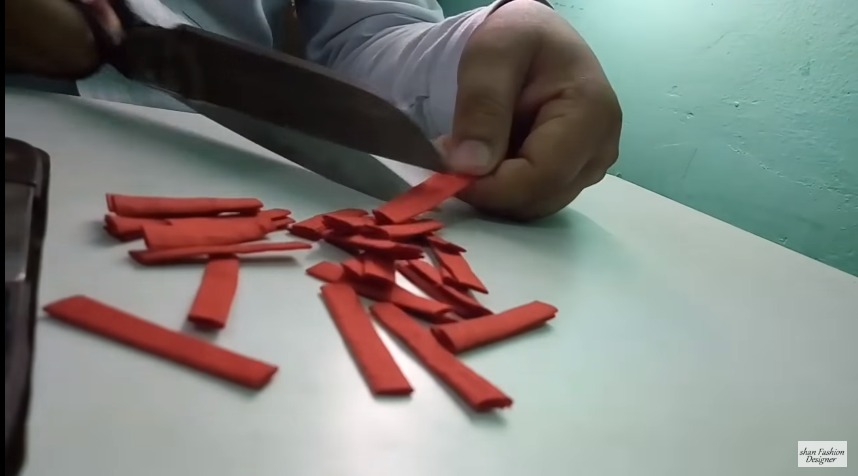
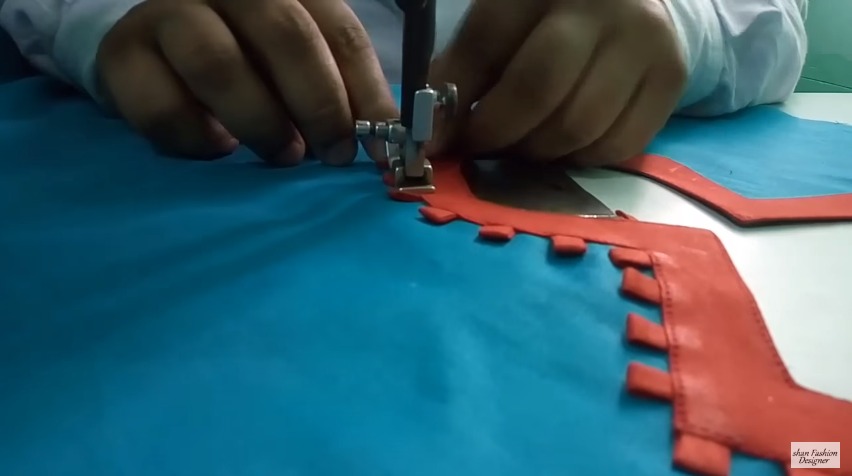
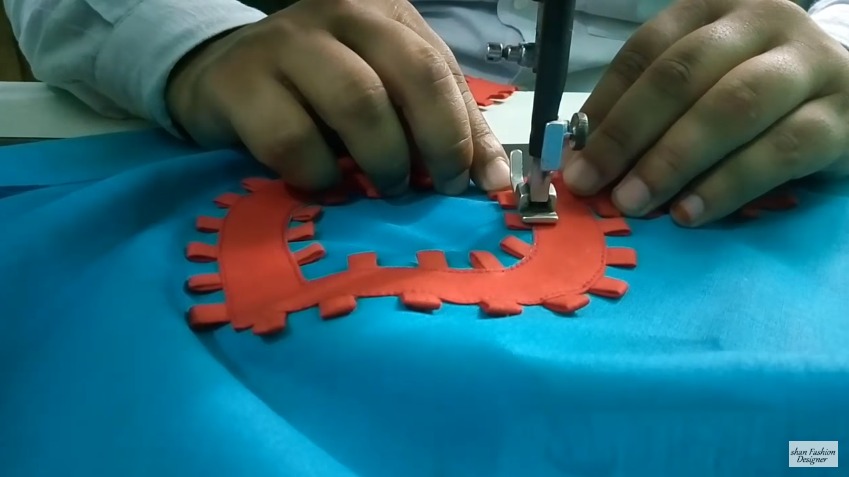
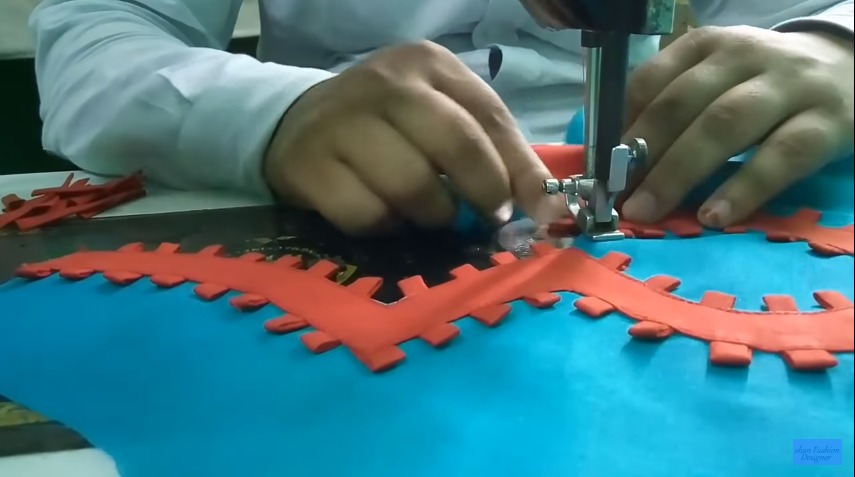

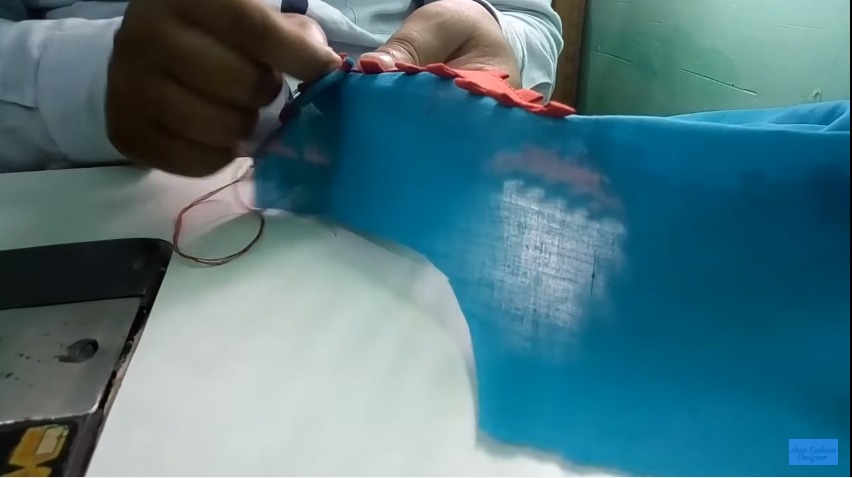
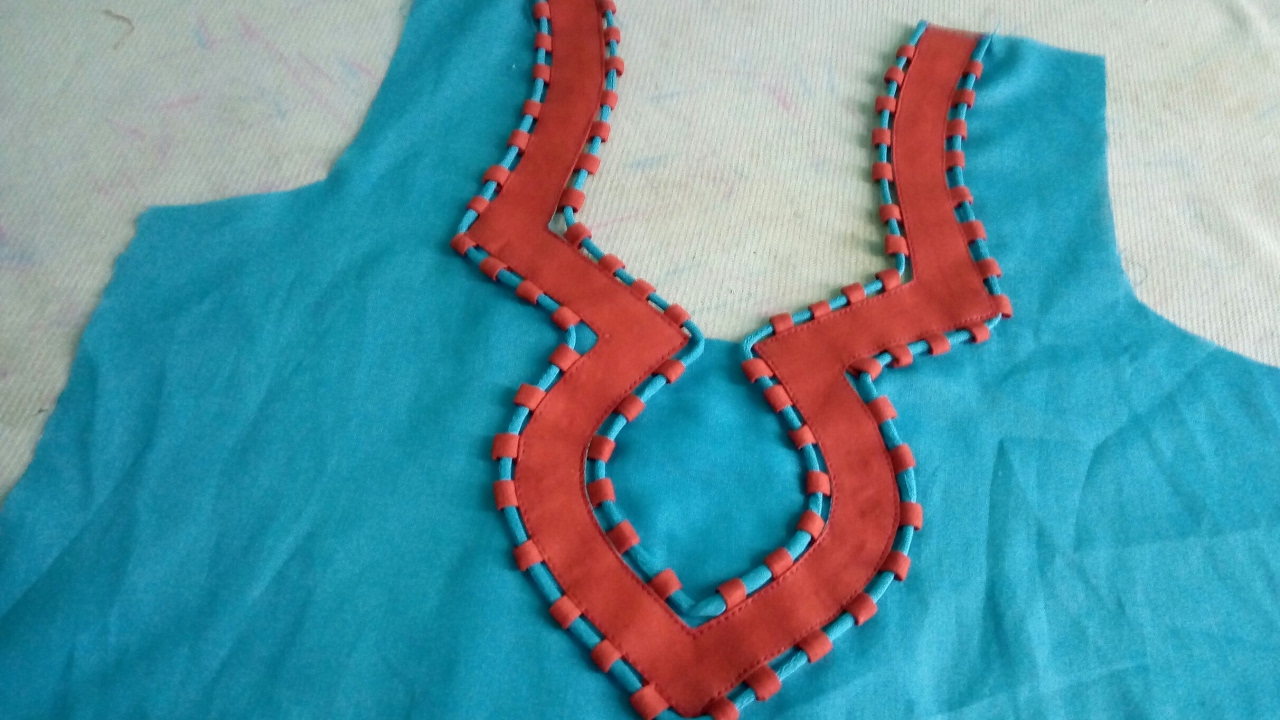
How to make a Bead of Marigold Flowers
Summer has come to an end, many flowers have faded, and therefore saving the variety of natural colors gradually subsides. But as long as the fall is not fully come into its own, you can still enjoy the latest colors of the season. One of the few flowers that still we are pleased – it marigolds. So what exactly it today and we’ll weave.
We need:
– beads № 11: orange, yellow and green,
– wire diameter 0.2 mm
– green thread for winding leaves flowers and stems.
As a model for the production of marigold Bead here I took the flowers, which are now in full bloom in our yard.

Each of our flower buds will consist of 4 petals series.
The first row will be the smallest petals. To take them 35 cm long, and the wire is first typed on it 5 yellow beads.
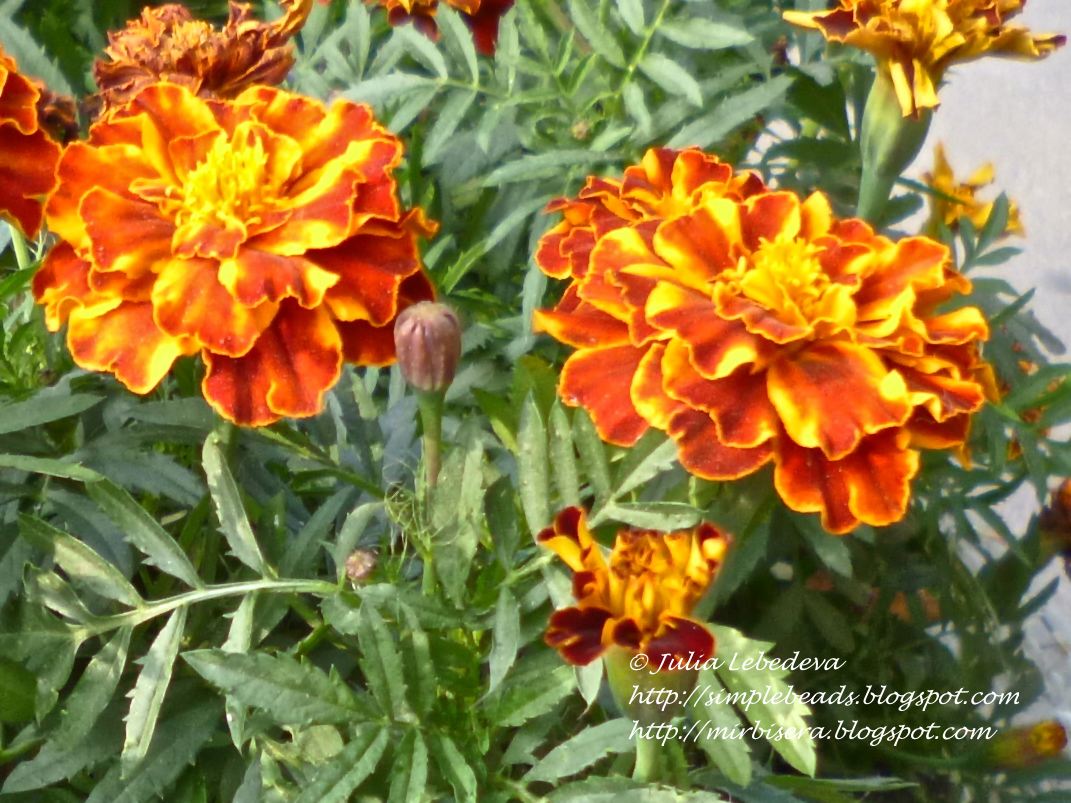

We place the beads in the middle of the wire, and then the loop consists of beads and twisting the wire underneath 2-3 turns. Thus it is necessary to loop of beads turned around in the middle of the wire.

Further, at each end of the wire adjacent to the first loop should be done even for one the same eyelet of the beads. Choose any of the ends of the wire, we collect it 5 yellow beads
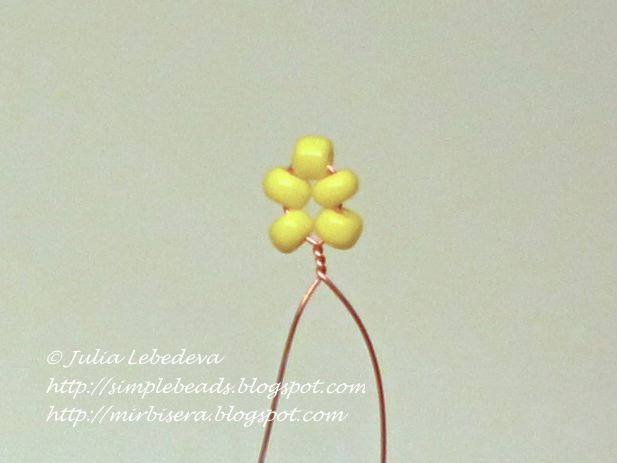
and twisting one loop, placing it almost came to the first eyelet.
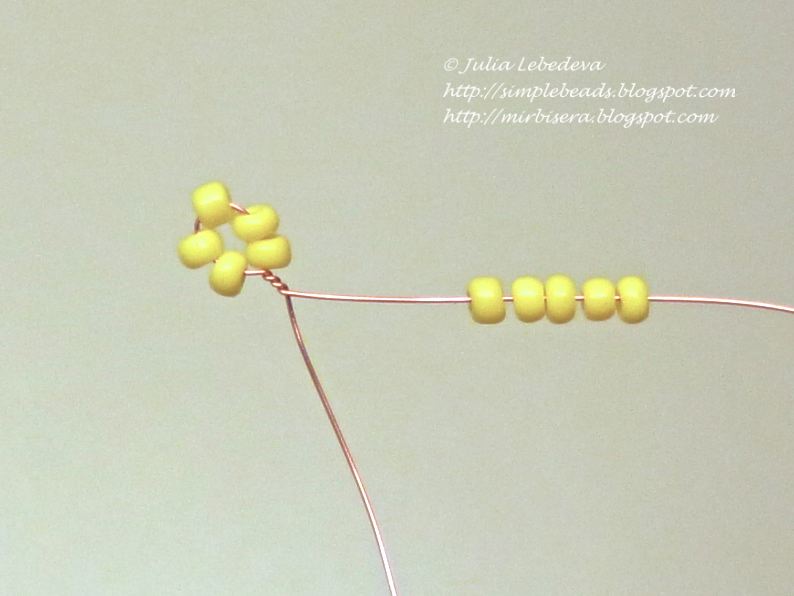
After that, another exactly the same loop of the 5 yellow beads do at the second end of the wire.
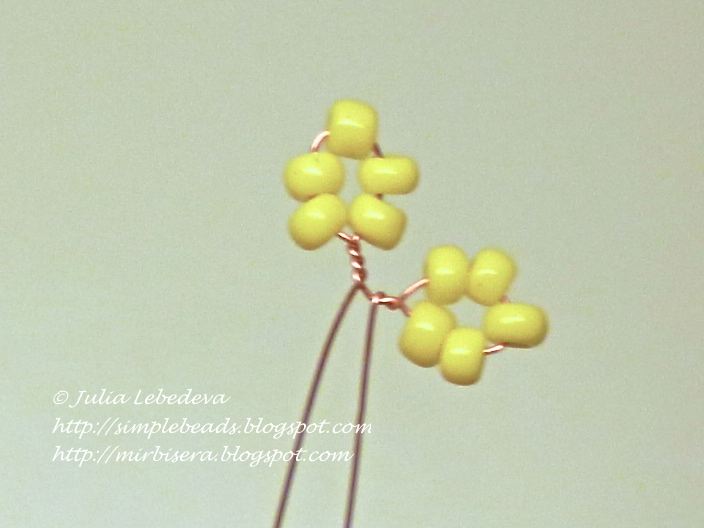
It remains to twist together the two ends of the wire – the first series of petals ready to bud.
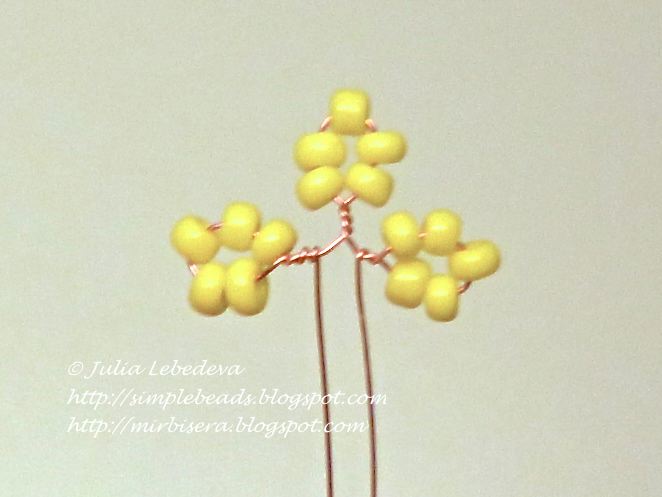
For the second series of petals take the wire length 60 cm. First, the wire 5 recruit orange beads and twisting of this loop, placing it at about 15 cm from one end of the wire.
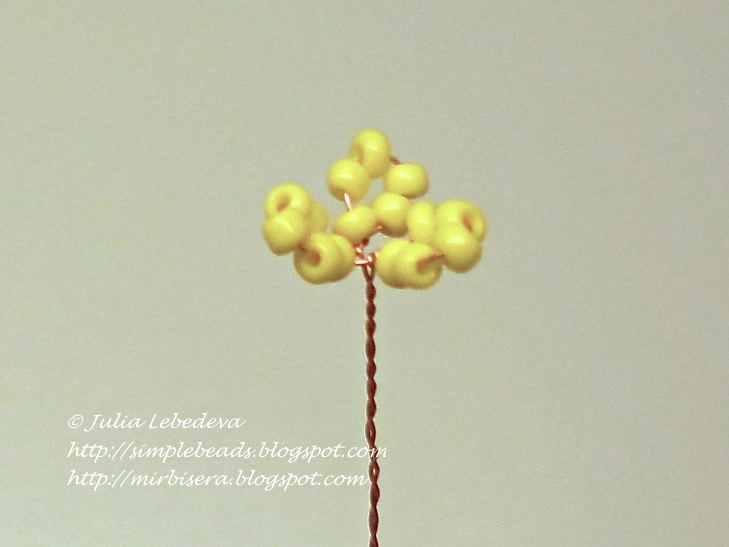
All further weaving are conducting only at the long end of the wire. We recruited him 12 yellow beads,

we add these beads arc over the first loop,
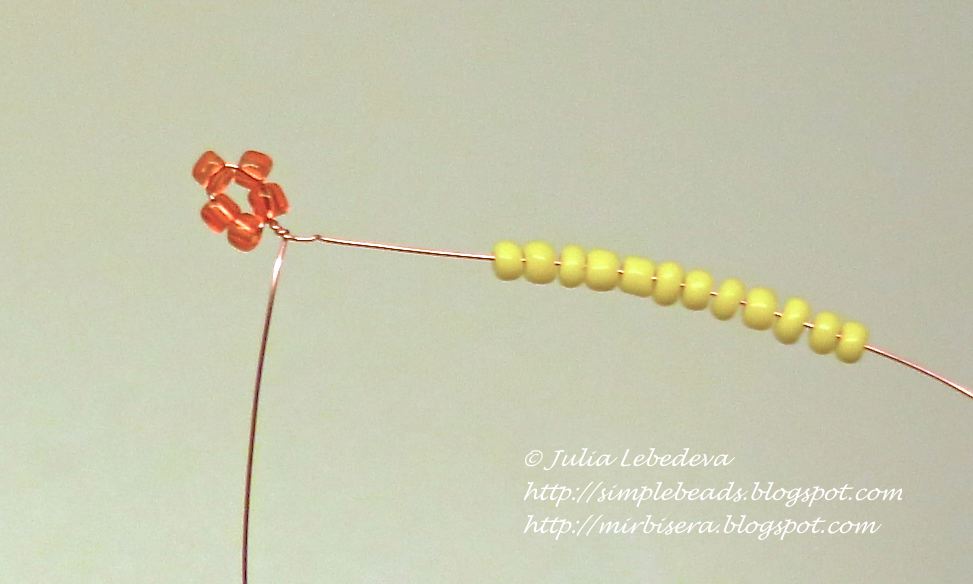
We pull a wire to the beads formed close to the first eyelet and twist the wire 2-3 turns. We get a second loop, located on the first flush. These two loops will form a first flap of the second row.

Next, in the same – long – the end of the wire is necessary to weave more of the same 5 petals. For the first tabs of the second tab is typed on a wire 5 orange beads
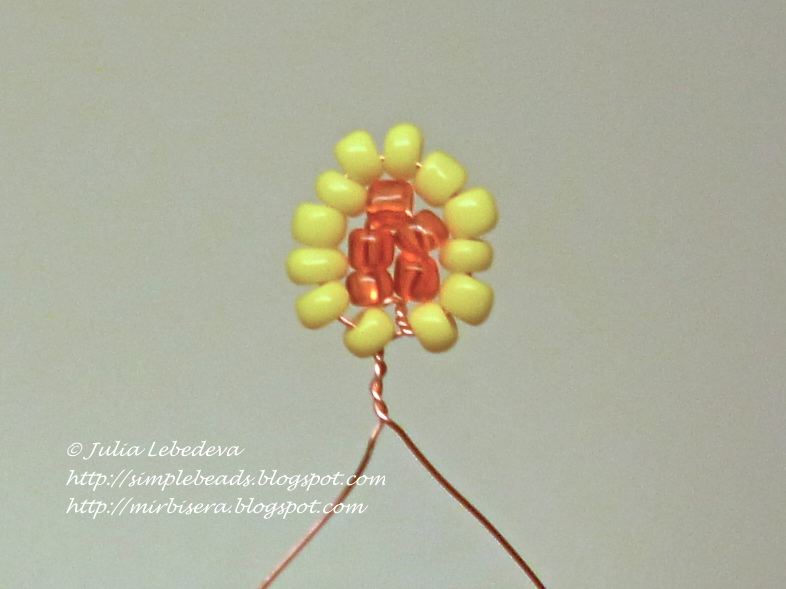
and twisting one loop, placing it at a distance of about 5-7 mm from the first petal.

Then, the wire 12 is typed yellow beads,
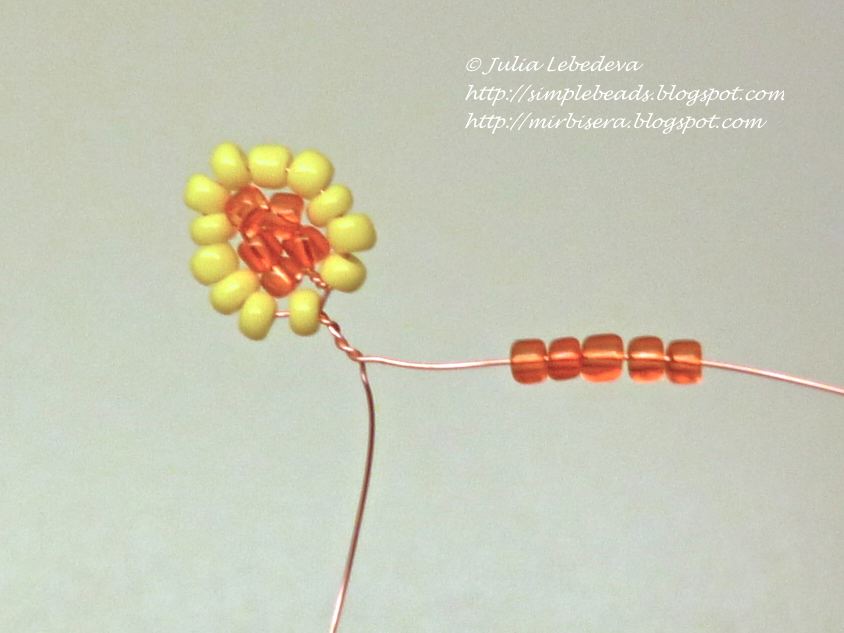
We add up these beads arc closely above the first lobe and the second loop wire twisting 2-3 turns. The second petal ready.
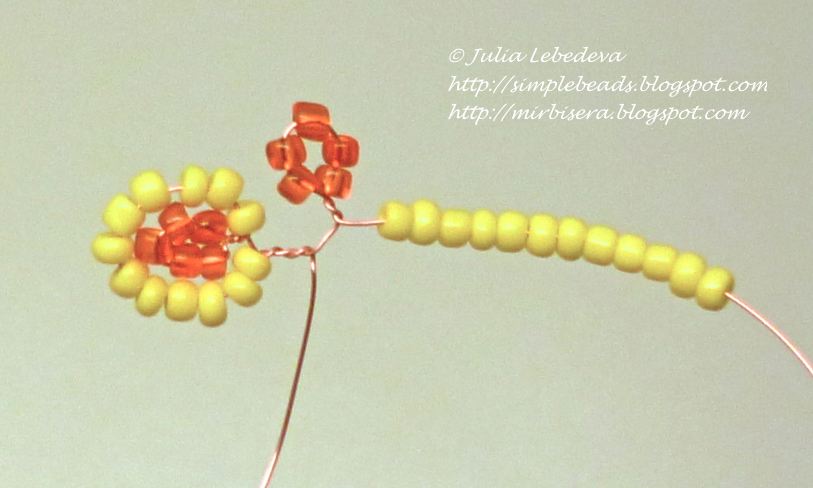
Similarly, we are continuing to weave at the long end of the wire the same pitch. Note: Because the beads may vary slightly in size from each other, it is possible for the upper loops must be taken not exactly 12 beads, and a little more or, on the contrary, a slightly smaller number of beads. The exact number of beads is not critical; but it is important to make sure that the loops in one lobe are disposed closely to each other, wherein the petal to look smooth, and that the upper eyelets on the wire were not visible voids.
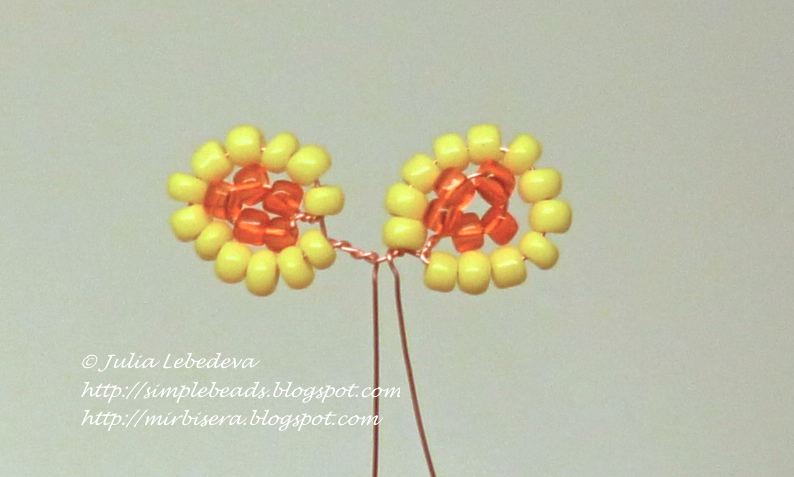
Gradually, as the number of petals intertwined, we can see that the petals start to like “crawl” on the edges of each other – this is normal; With this arrangement, the petals of the flower bud will collect much simpler than when there is a distance between the petals.

Total for the second row has to weave on a single wire, 6 petals.
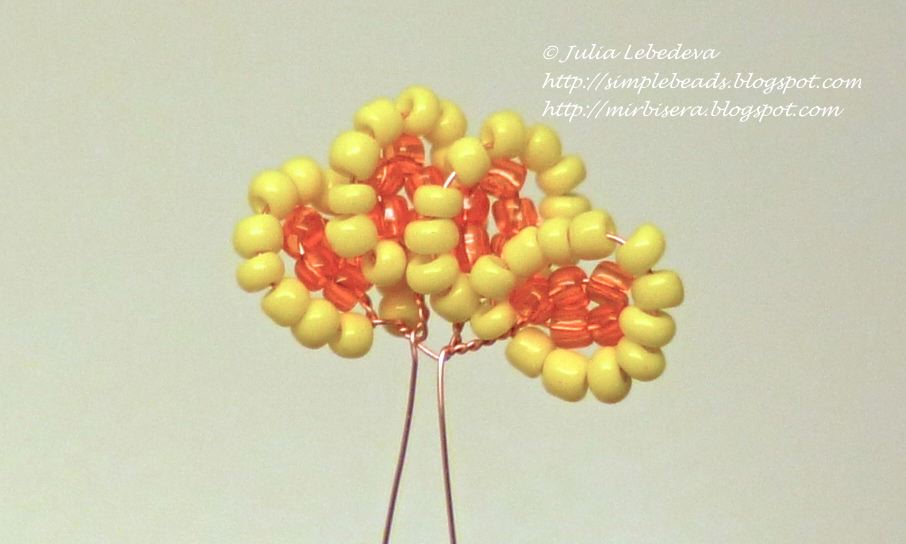
To petals woven series are not lost, just join them. Take the first row of petals, insert it into the middle of the second row of petals
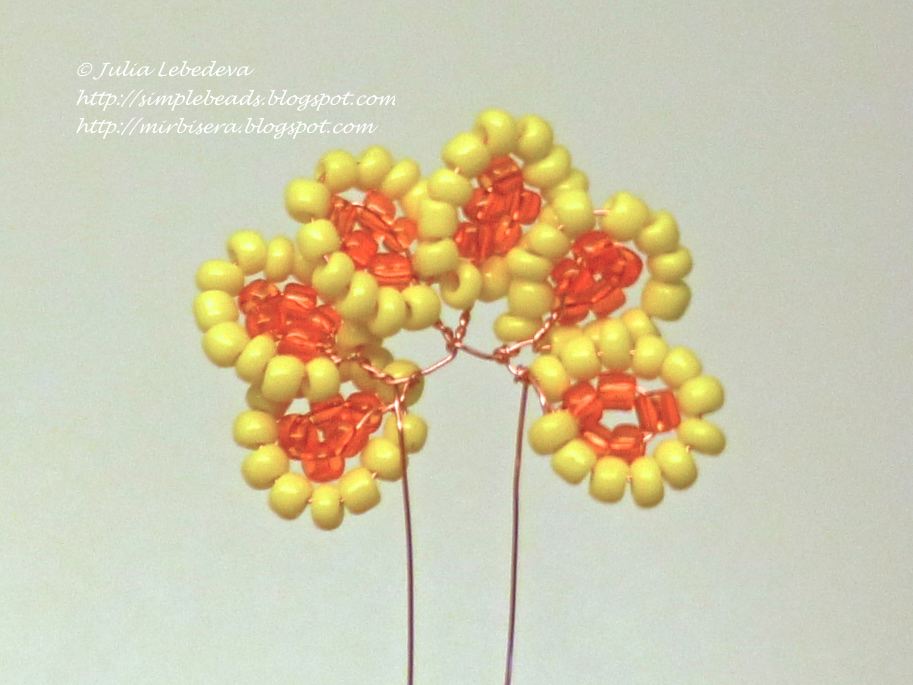
and twisting together the ends of the wire. In this case, the pitch of the second series of circumferentially uniformly distribute that between any adjacent petals was the same distance.
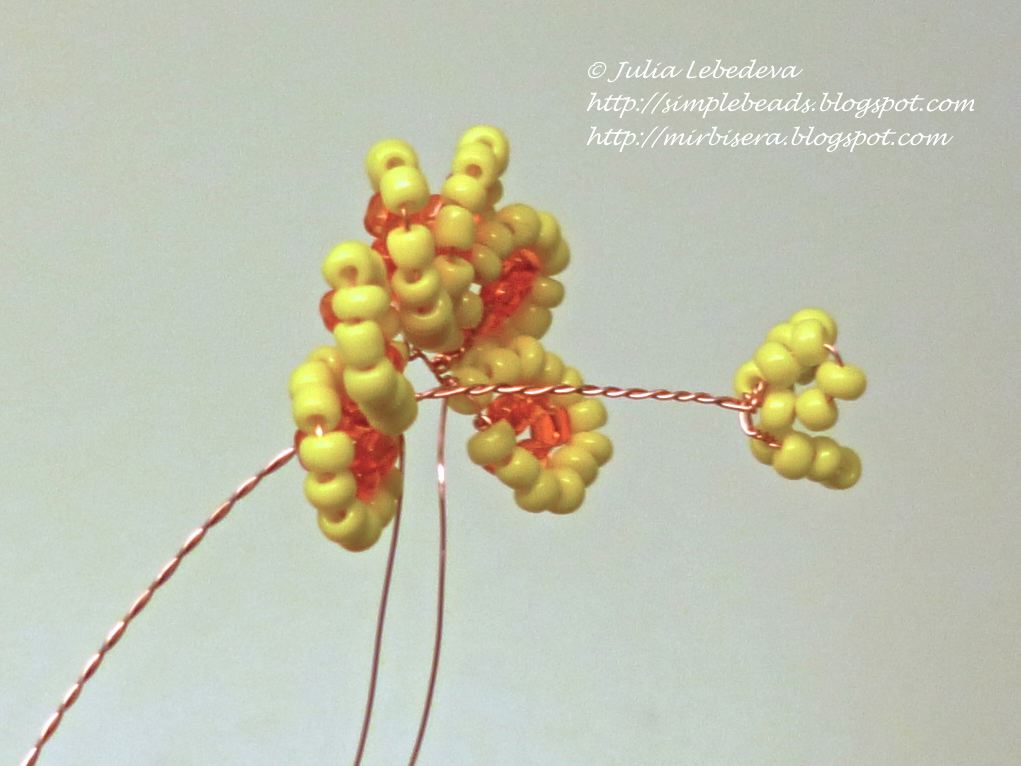
We leave for some time to get part of the bud and proceed to the weaving of the third row of petals. To take it a wire length of 80 cm. 6 petals must weave on this wire. Petals weaving technique – is the same one we used to weave the petals of the second row, but only one lobe of the third row will consist not of two but of three loops.
Making the first petal: its first loop consists of 5 orange beads. This loop, as in the second series weaving beams, in place of 15 cm from one end of the wire, and further braiding are conducting only at the long end of the wire.
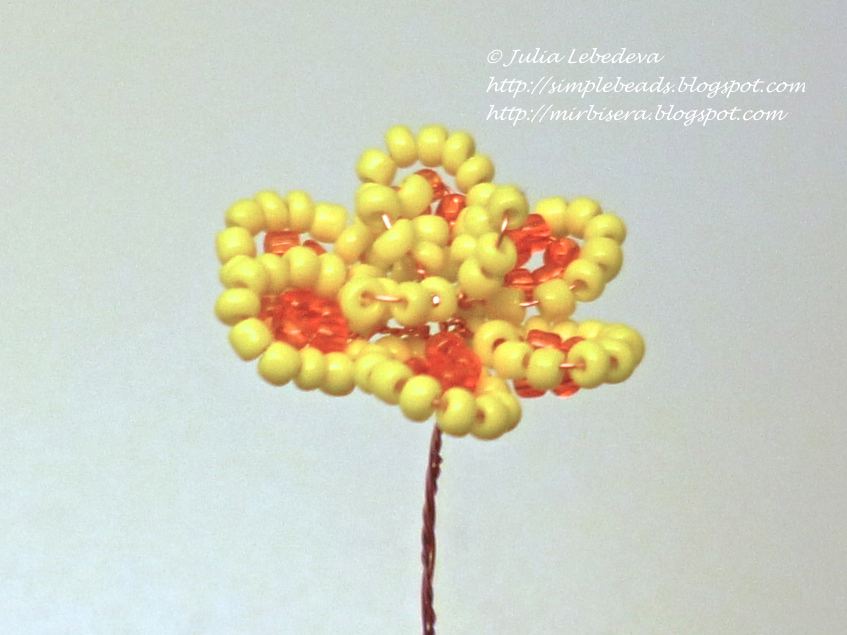
The second loop lobe consists of 12 orange beads.
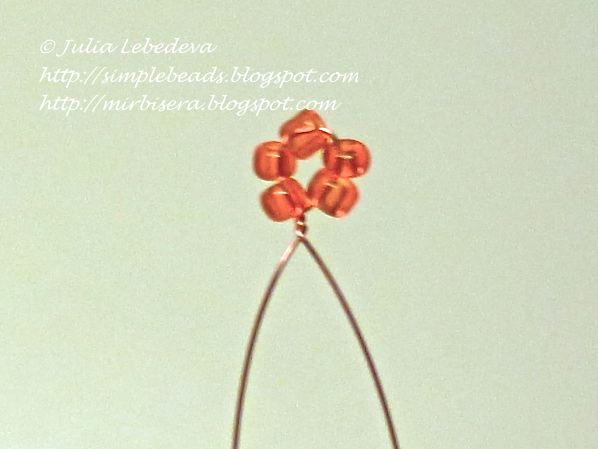
The third eyelet 19 comprises a petal of yellow beads.

The remaining petals similarly. The first loop of each next lobe (5 orange beads) are placed approximately 7-9 mm from the previous one lobe.
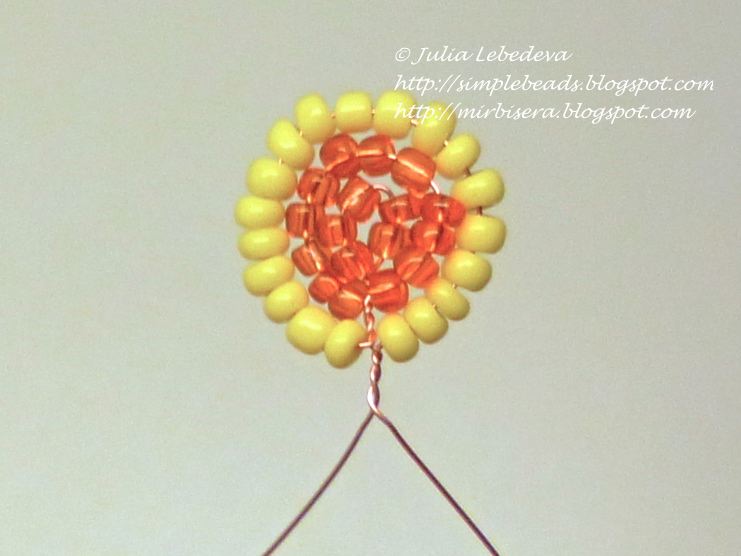
The second loop in each petal of this series consists of orange beads. A number of beads, as I noted earlier, is approximately equal to 12, but may be slightly different.

The third loop in each lobe of the current series consists of yellow beads (standard – 19 beads).
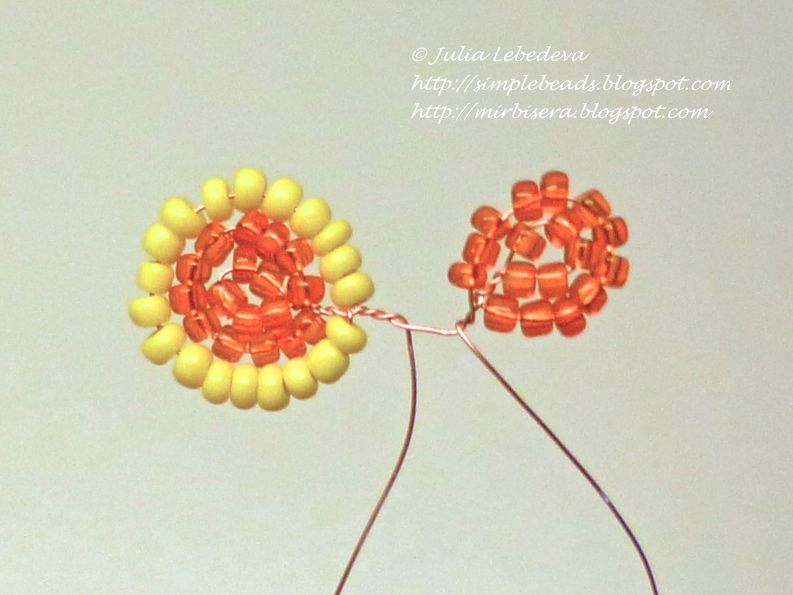
Thus only this wire 6 petals for the third row of the bud.

After the completion of the third row of weaving petals attach it to Bud: take already joined together the first two rows of petals, insert them into the middle of the third row

and twisting together the ends of the wire. The pitch of the third row, as usual, is uniformly distributed over the circumference.
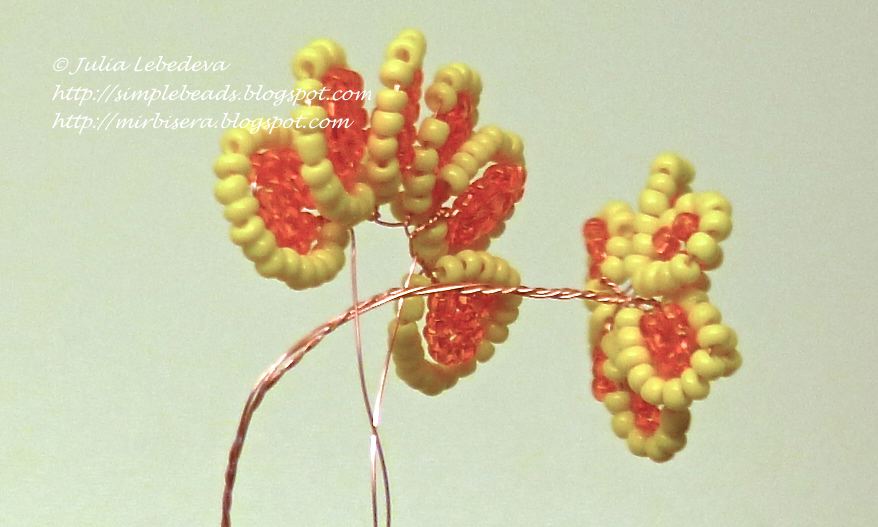
Side view of the bud at this stage:
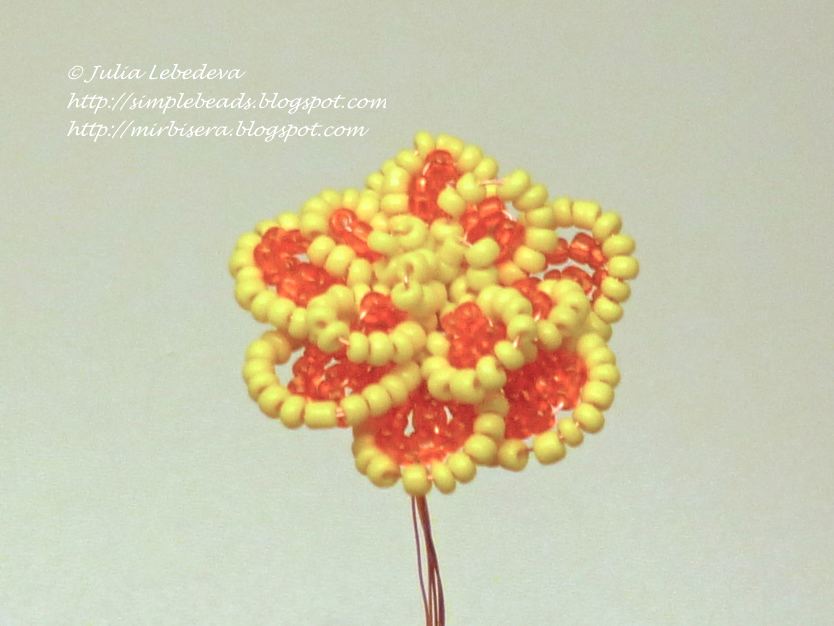
Next, we do the fourth row of petals. In this series, all the petals are also the same, but they are lagging individually, so each petal take the wire length of 40 cm. The petals of the 4th series are very similar to the petals of the third series, the difference between them is very small.
First, we make the first loop – it consists of 5 orange beads. As each petal separately, the first place on the middle of the loop wire.
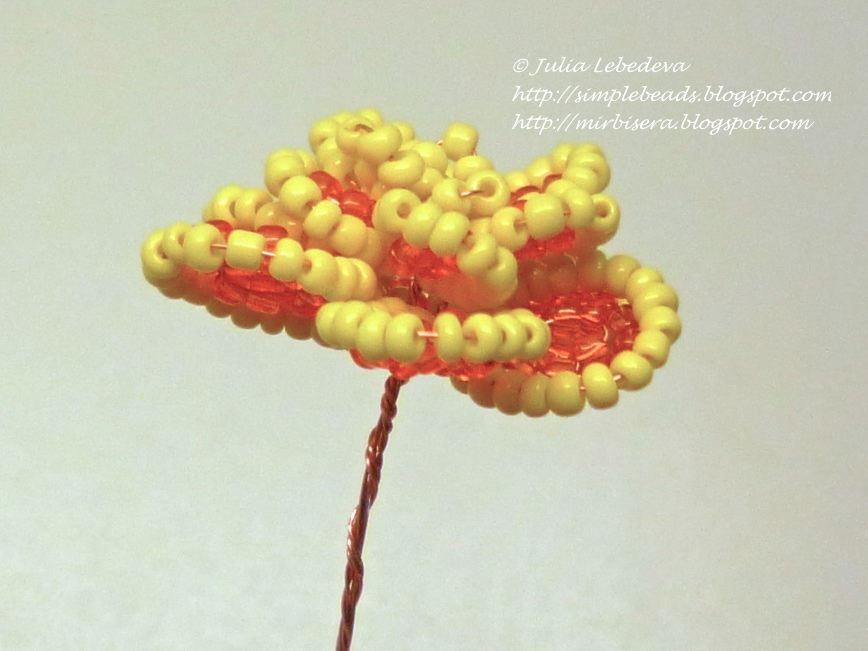
For the second loops to choose from two ends of the wire shorter (if both ends of the wire exactly the same, then choose any of them), and recruited him 12 orange beads.
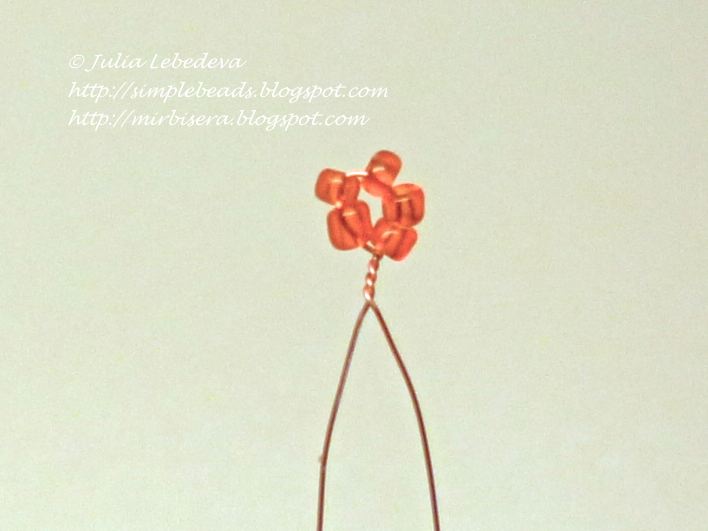
As usual, we add these beads arc closely over the first loop

and twisting the wire by 2-3 turns.
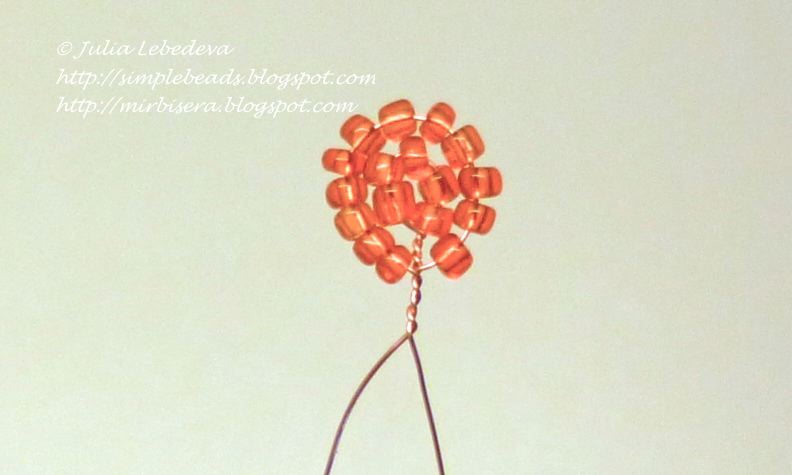
For the third loops, select the longer end of the wire and recruit him 19 yellow beads.

Bend the end of the wire with beads of arc recruited over the second loop,

and tolerate the other end of the wire through the last dialed bead.
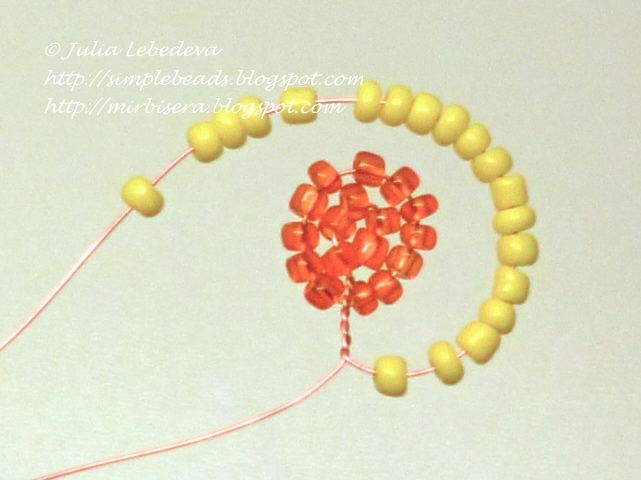
Tighten the wire making sure that the yellow beads formed the third loop of the previous two,
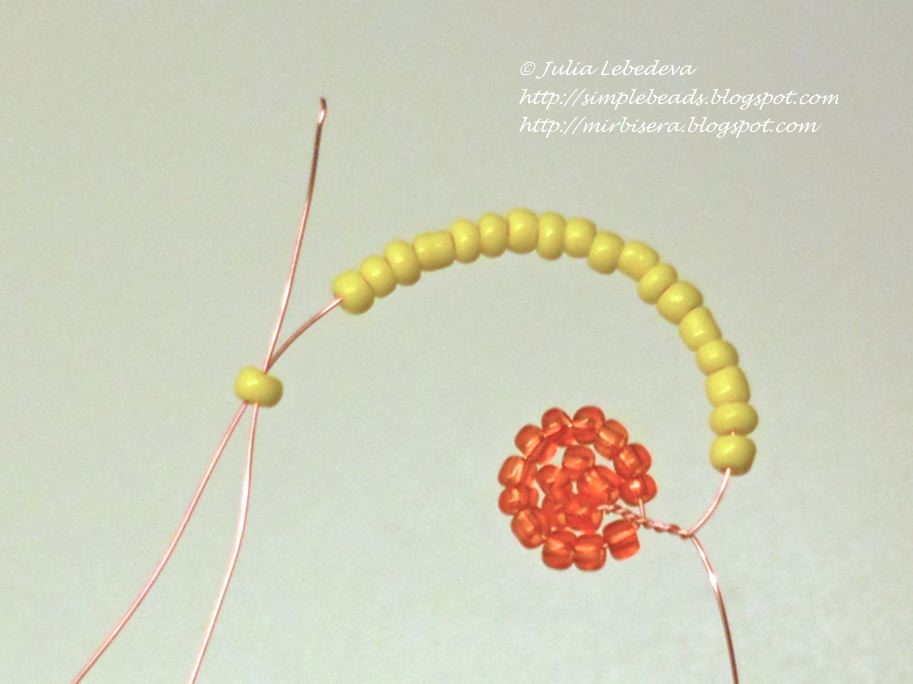
and then twisting together the two ends of the wire. Petal ready.
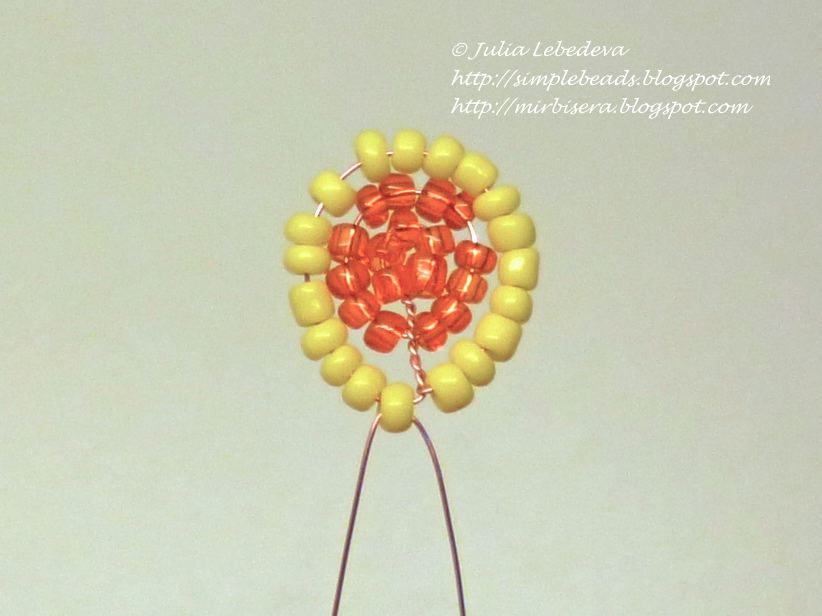
Total for the 4th series bud needs to weave these 8 petals.

After all 8 petals are ready, we collect them together. To do this, take the length of wire 30 cm long and consistently “stringing” him all the petals of the 4th row, passing this piece of wire through the yellow bead, located at the base of each petal.
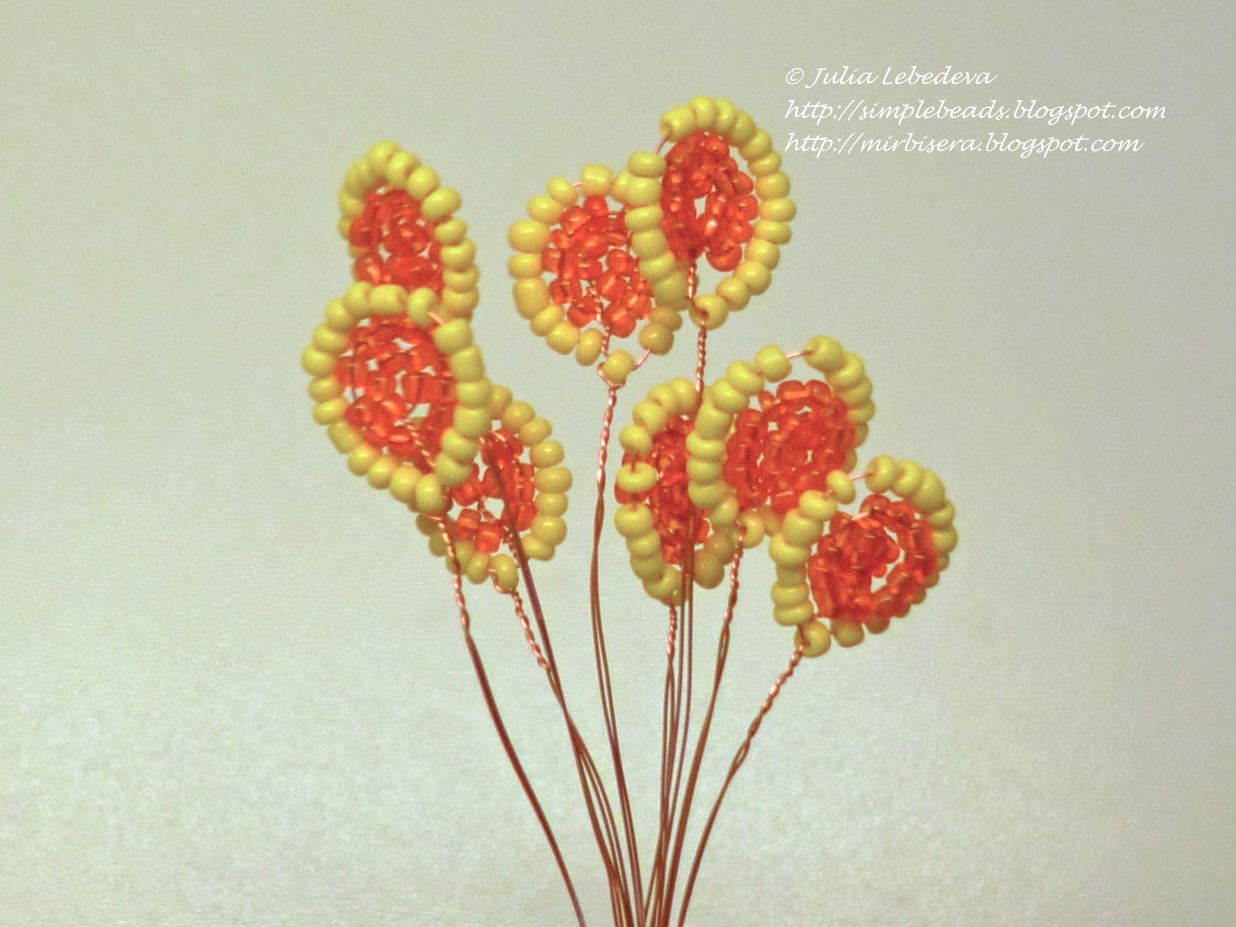
We pull all the petals close together, align the ends of the additional wire and twisting them together with a few turns. Please note: we now only curl the ends of the additional wire; the ends of the wires coming from the petals until all together do not twist!

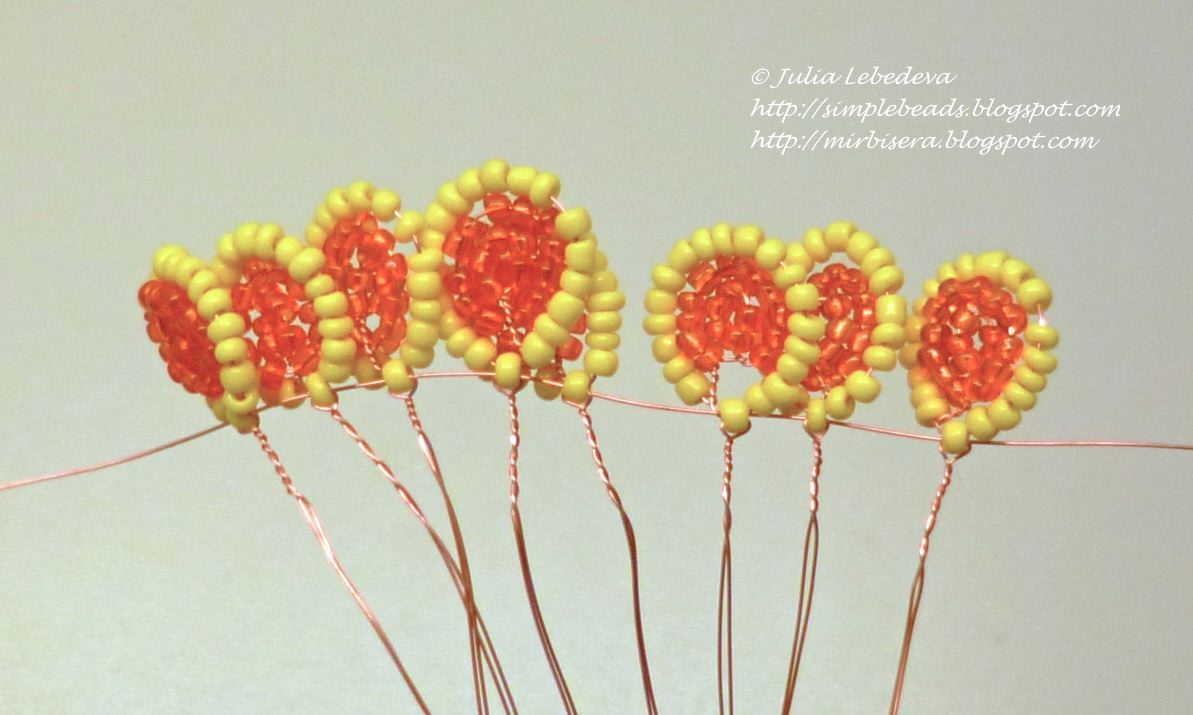
Next, we place a bud on the desktop so that the upper part of the bed was directed to a table and straighten towards the end of the wire coming from the petals of the 4th series (of each petal there is a two twisted with each other end of the wire – to untwist them is not necessary). On each such pair of ends of the wire extending from the petal, dial 8 green beads. Similarly, we proceed with an additional wire, which collected the petals of the 4th row. Total for each of the 9 pairs of wire ends need to dial 8 green beads.
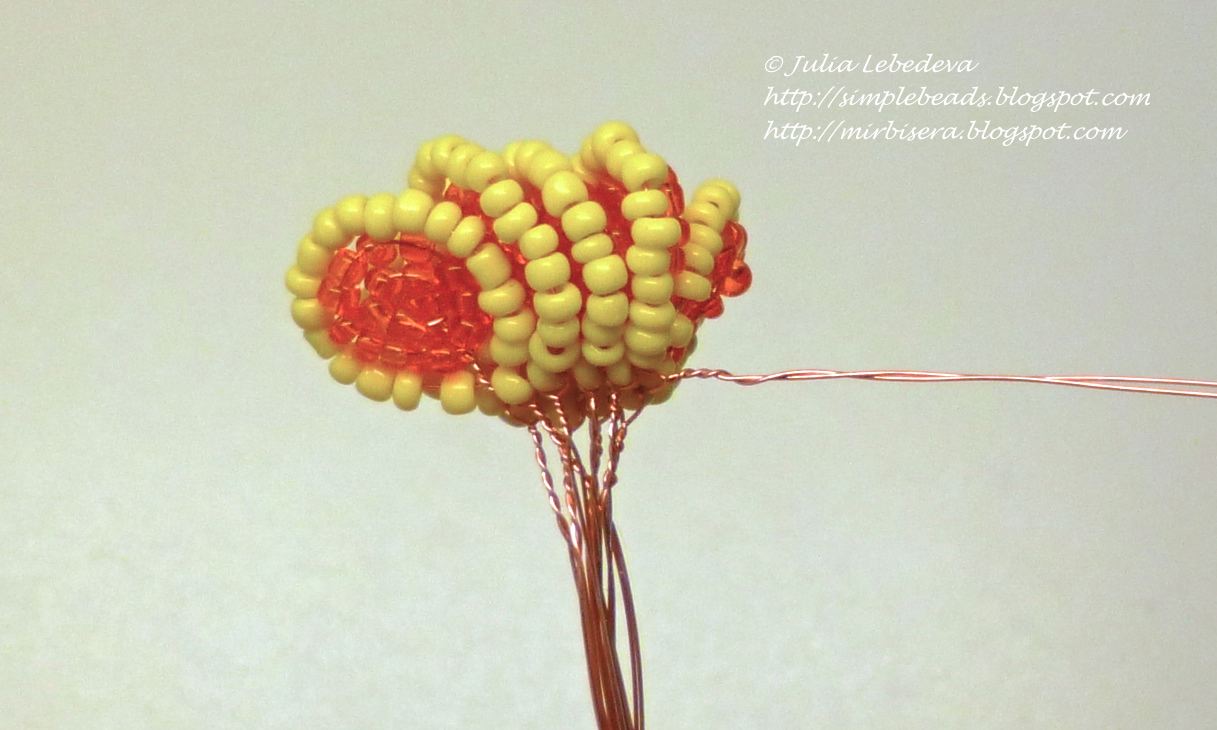
Putting it all ends of the wire together and pulls all the green beads close to the bud.
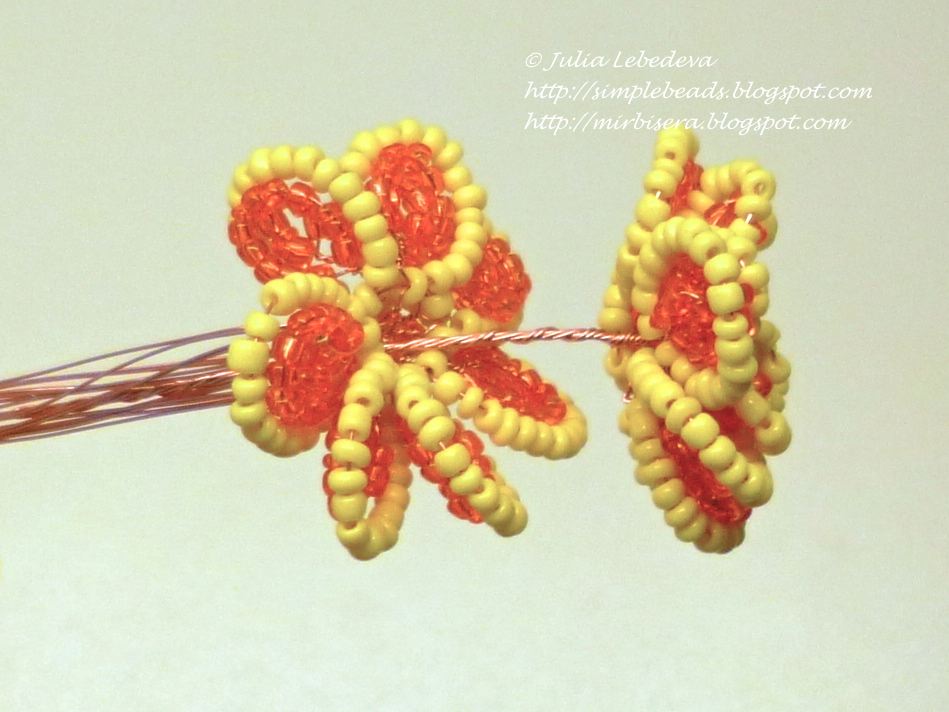
Check to the fourth row of petals was a close 3rd near the petals, and then twisted together all the ends of the wire from the bottom of the flower.

Flower bud ready. We leave it for a while and move on to the production of leaves.
The leaves of marigolds – components; Each sheet consists of numerous narrow leaves: central and located them pairwise multiple rows of the same leaves. In appearance marigolds leaves are very similar to the leaves of mountain ash. Since our website is already a master class in weaving rowan beads, then we will do the leaves of marigolds on the already known scheme. So we go here on this link (master-class will be opened in a new tab) and make the necessary us the number of leaves. Note:. For every little leaf rowan we take the wire length of 25 cm for leaves marigold same will be enough to take the wire length of 20 cm (you can even slightly less, but in a very short wire is inconvenient to weave).
The number of leaves that need to weave for each flower, depends on your desire. The more leaves, the will be more lush look ready bouquet of marigolds. I recommend for each flower to make 3 or 4 sheets.

After all the leaves are ready, we proceed to the final assembly of the flower. First we take the green thread and winding them petiole of each leaf in between and still leaves about 2 cm after leaves.
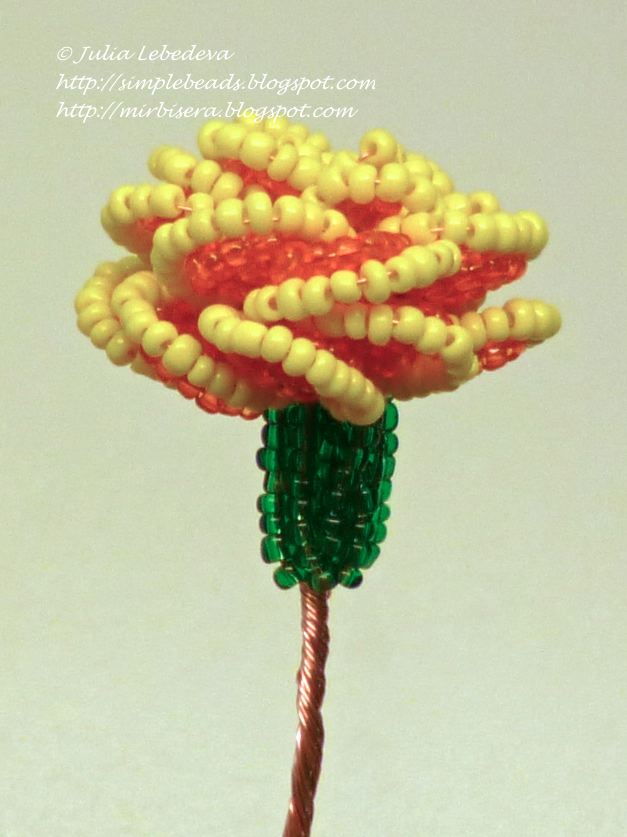
Then, the same green thread winding stem of the flower bud under approximately 3 cm in length.

Now we take one sheet and attach it to the stalk by the same thread.

Continue winding stem thread More approximately 2-3 cm, and then using the same thread to attach the stem another sheet.
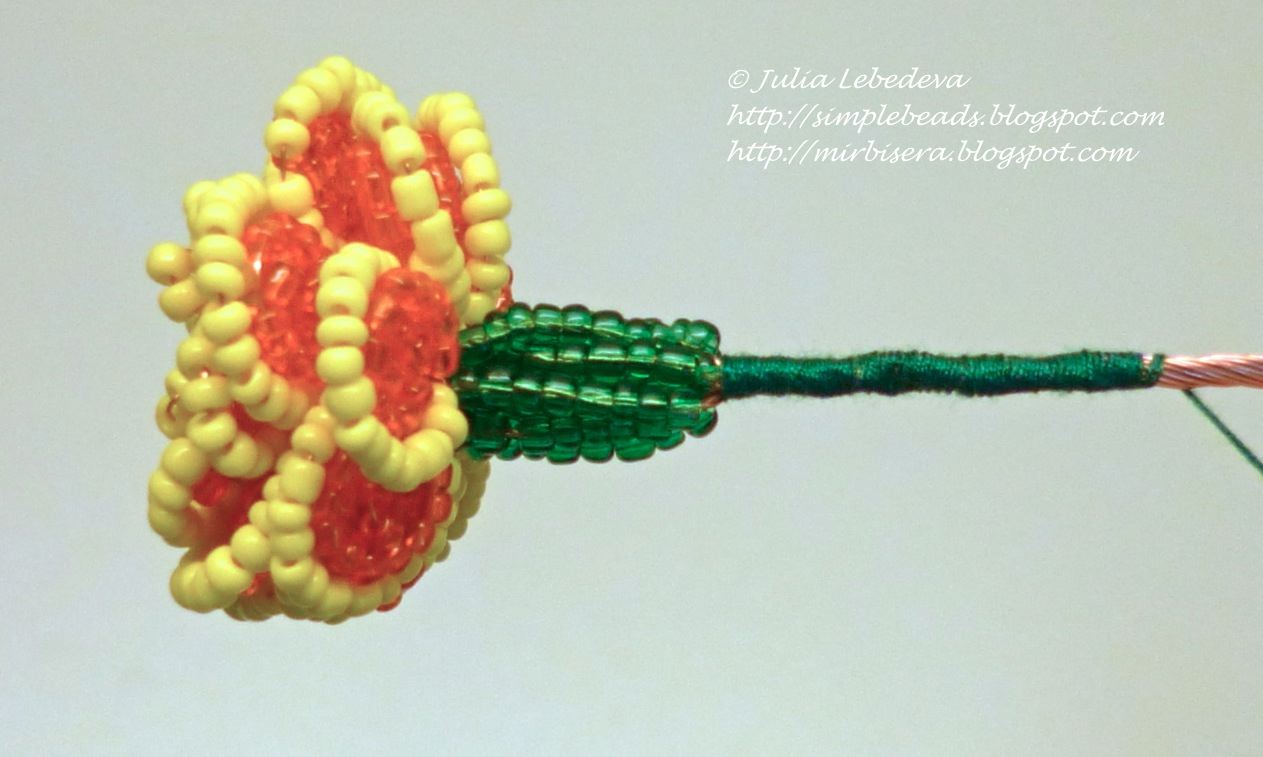
Thus gradually attach to the stem all the leaves (this implies that the leaves were placed on the stem circumferentially) and the winding stem green thread over the entire length.
To thread not dissolve, tying them for a couple of knots. If necessary, trimmed at the bottom left of the stem ends of the wire.
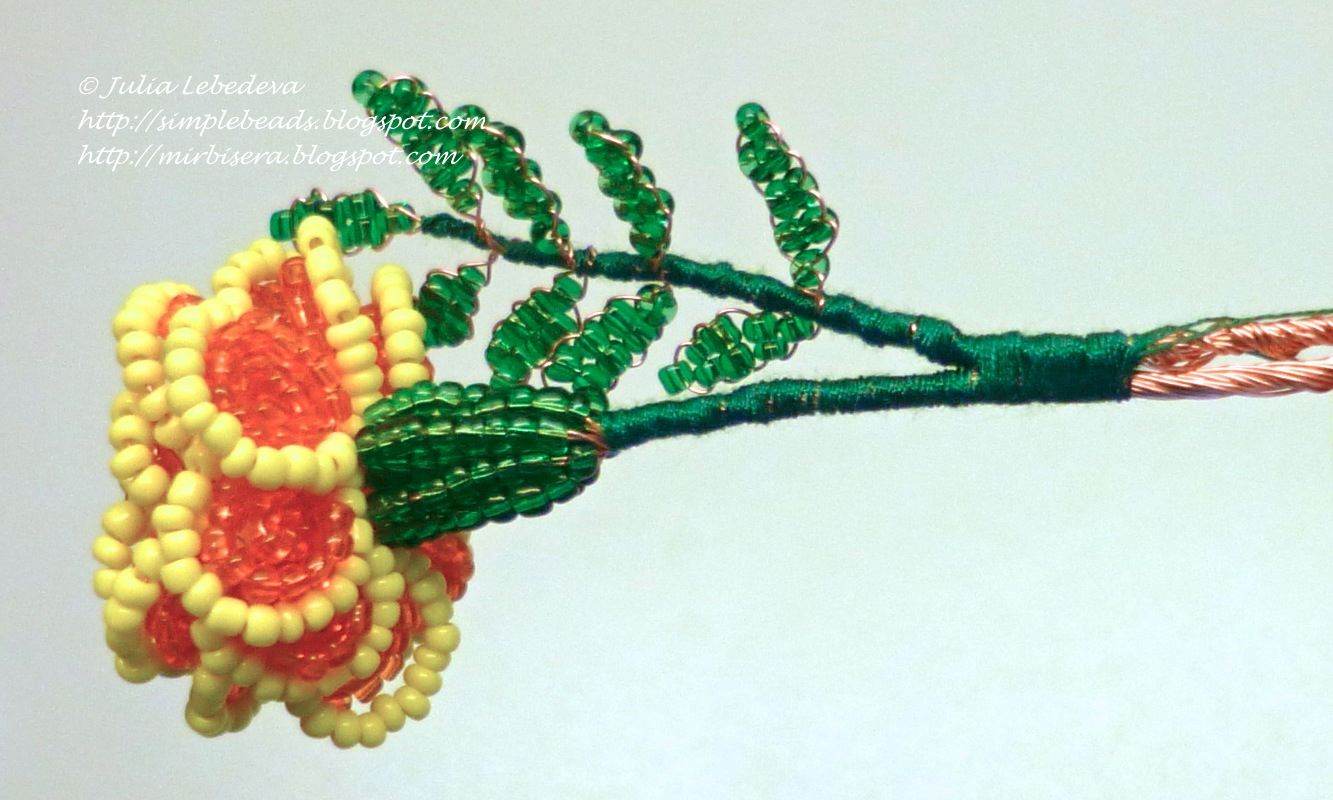
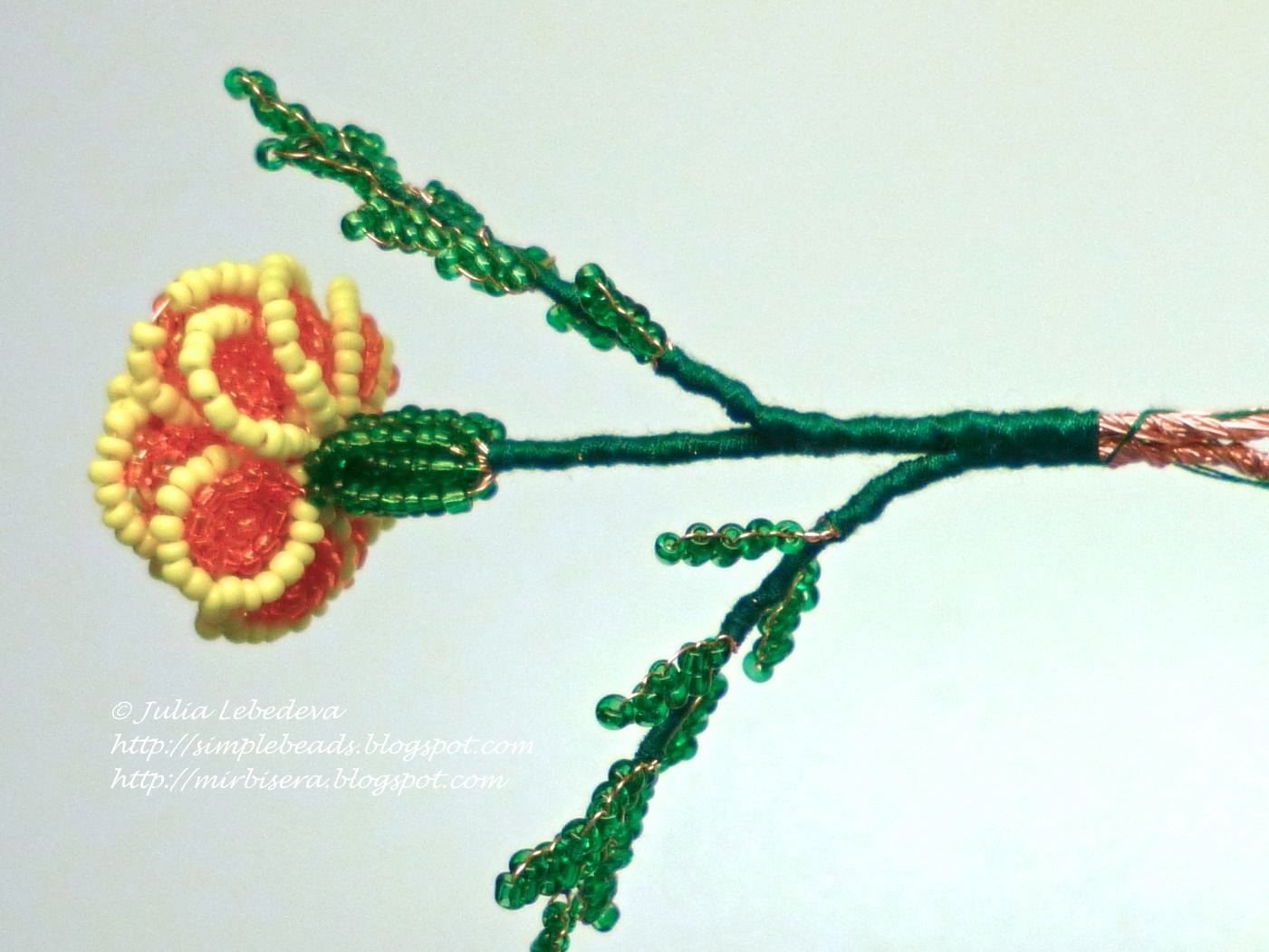

One flower is ready! I made three of the flower and the resulting bouquet of marigold put in a vase.

courtesy: mirbisera
DIY Vase of branches made from plastic bottles
I made a vase of disposable glasses, decorated with an elastic tip and pasta; branches made from plastic bottles.
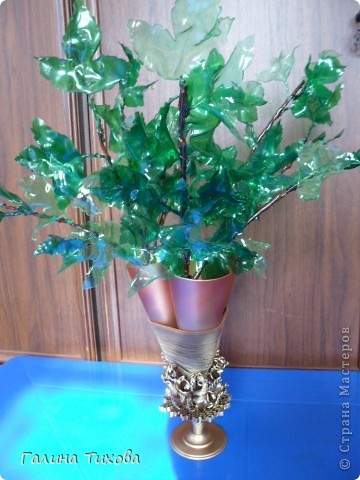
To work on a vase I need: 3 disposable glasses, PVA glue, elastic sock, shaped pasta Melt glue and spray enamel.


Three wine glasses pile up as follows:

Elastic socks are well soaked in glue PVA
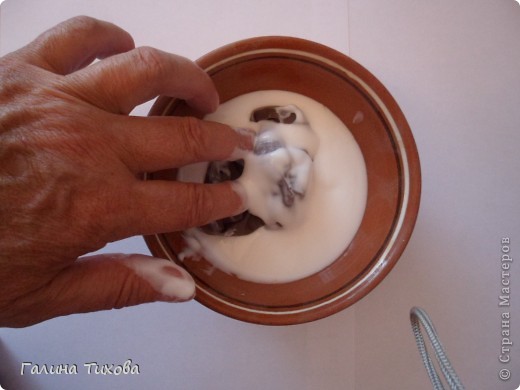
I put it on the bottom glasses, doing drapery and leave to dry.
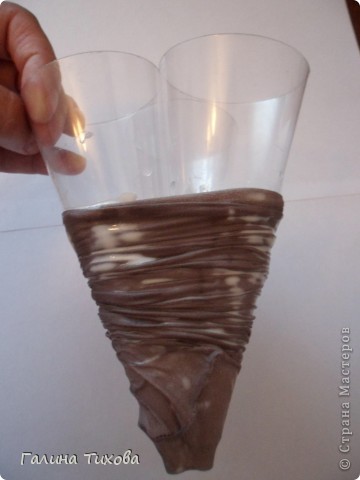
Two wine glasses on the stand Thermo glued together, as shown in the photo
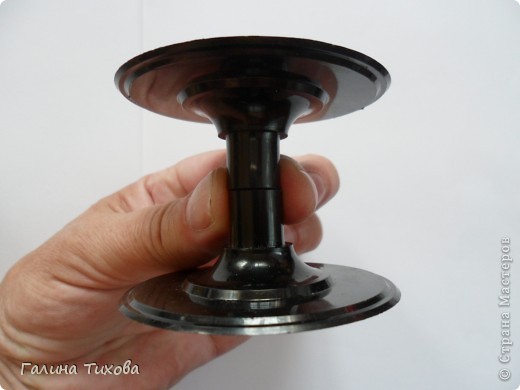
When the glue is dry, begin to decorate curly pasta, pasting them Melt adhesive.
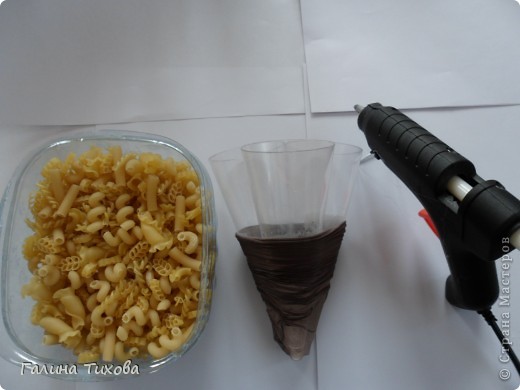
Next pasting glasses to the stand
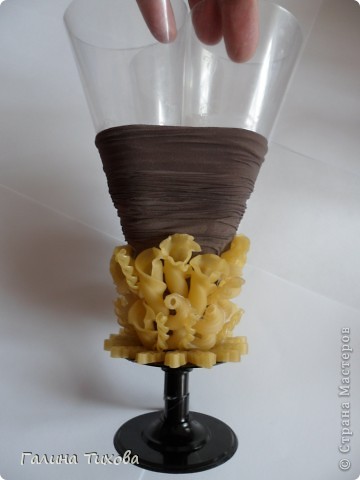
Now paint aerosol paints. The upper part of the color “Old Copper” bottom – paint brown
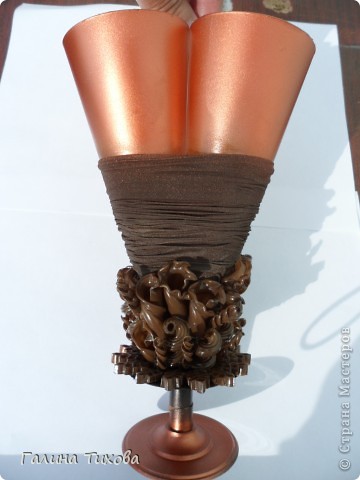
Then everything is slightly enamel.
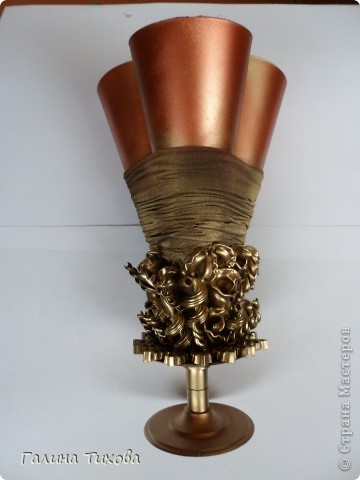

Here is a vase I got
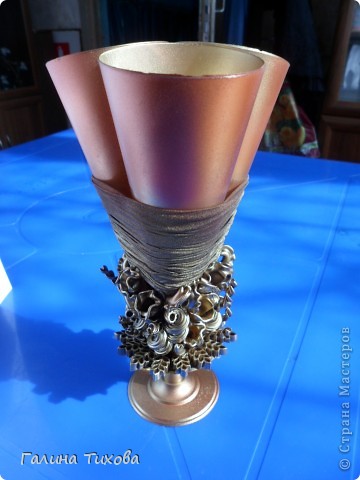

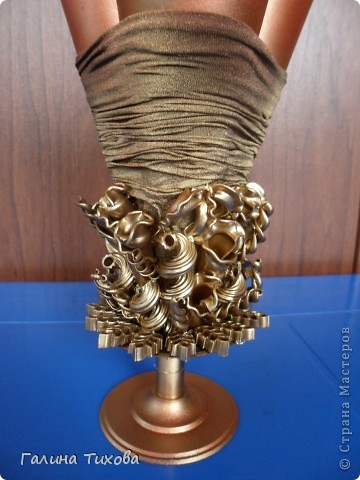

For making branches receive a green plastic bottle, neck and bottom cut off.
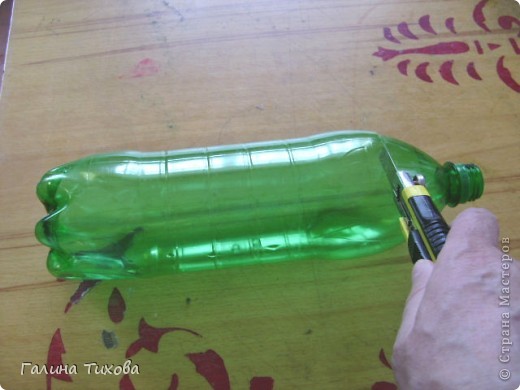
For work, I need the middle part.

From paper-cut stencils for the leaves.
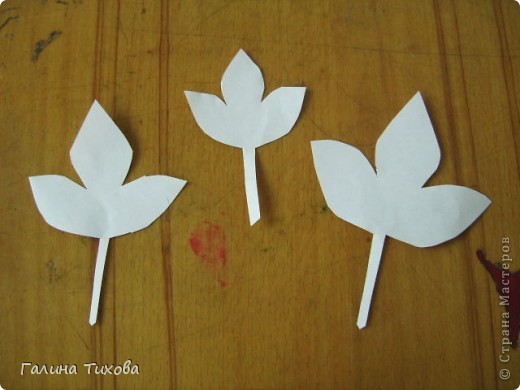
Stencil cut out leaves from the middle of the plastic bottle.

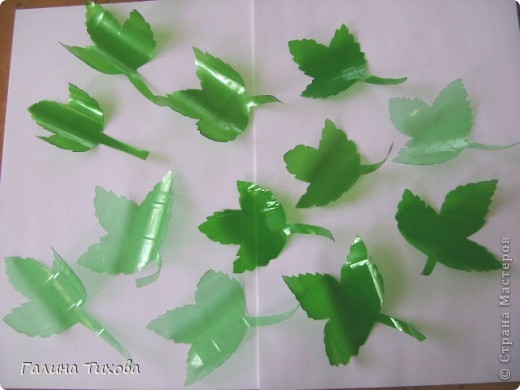
Stencil cut out leaves from the middle of the plastic bottle.
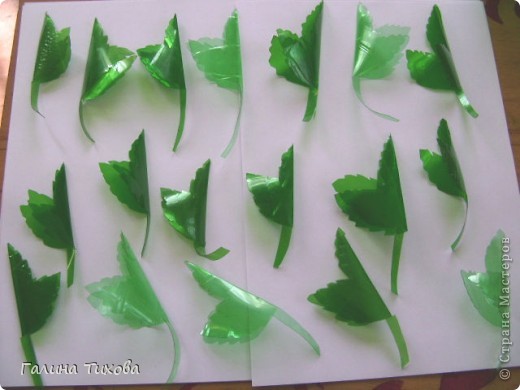
Over a candle flame gives the sheet shape. It is important to remember that the candle flame must not touch the sheet workpiece. Sheet form gives hot air instead of a flame. The work should be carried out in a well-ventilated area!
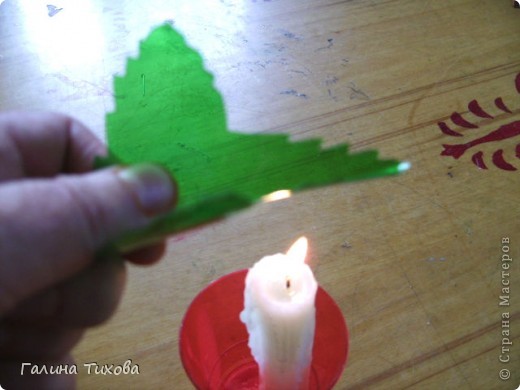
Leaf stalk spirals, softening it over a candle.

These are the leaves I did.
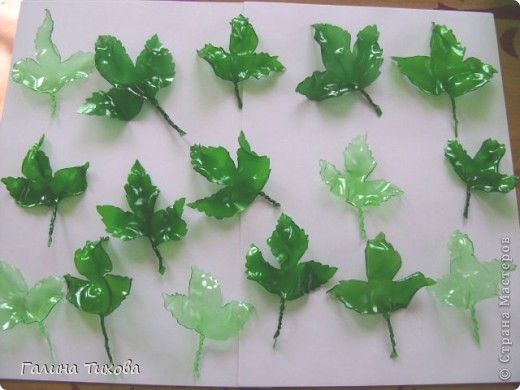
For the manufacture of the branches take a plastic bottle of brown color and cut it in a spiral to form a strip approximately 1,2sm

I twist the strip in a spiral, softening it over a candle flame.
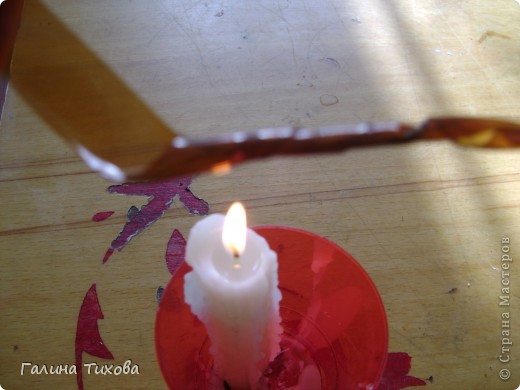
To connect the two branches together, the end of one branch in a candle flame and quickly presses it with pliers to the other branch.
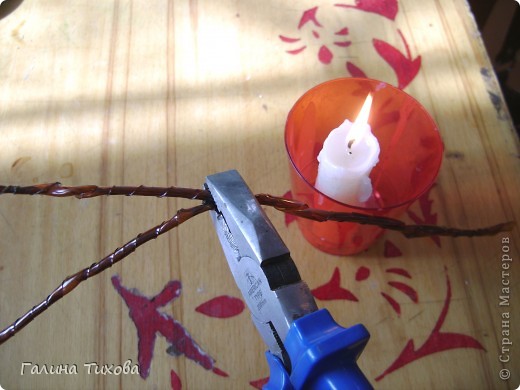
In the same way, I attach the leaves to the branch.
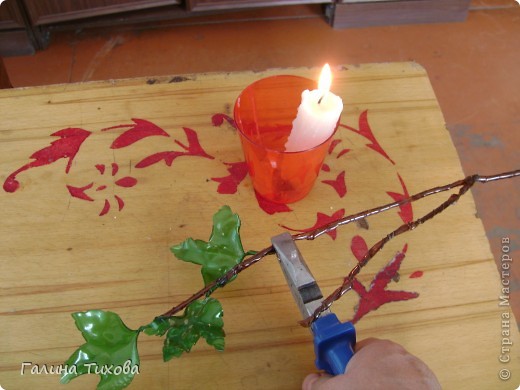
These are the branches and leaves I did.
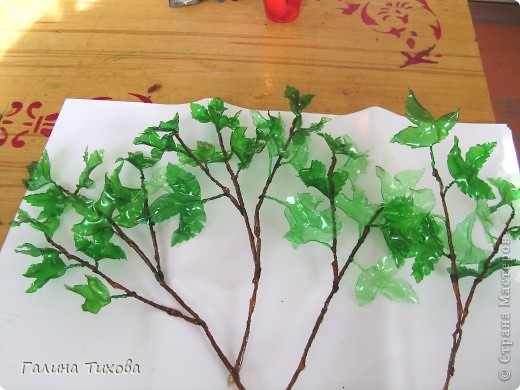
I put twigs in vases cell.

So, enjoy The result of my work.
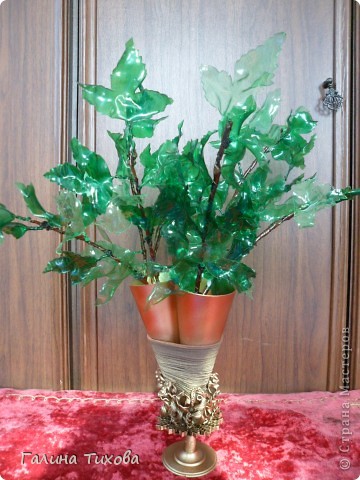
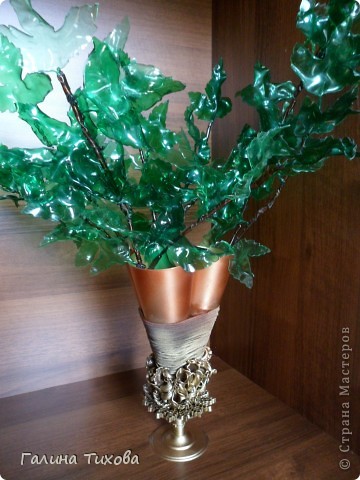
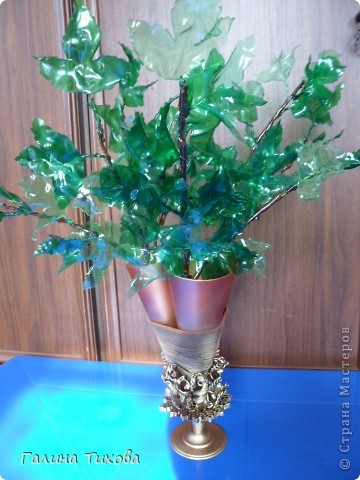
courtesy: stranamasterov
How to Make a Pencil Holder with Popsicle Sticks
We suggest you try this because instead of just throw the “unnecessary” thing (empty can), you get a very desired, such as pencil holders.
We offer to make an unusual decor banks wooden sticks. We have created such a lovely pencil holders and in this master class, we want to tell you how it’s done.

Required Material:
Wooden Sticks (flat). These can be sticks for ice cream or bamboo garden labels.
Acrylic paint.
Can.
Narrow rep ribbon.
Polubusiny.
5.List porous rubber 2mm thick.
Brush.
Thermal adhesive gun.
Scissors with pointed ends.

Before you begin decorating the banks, it is necessary to process the upper edge. All sharp protruding bulges need a hammer or other heavy object, or a file to file. Once the edge is processed, you can begin to work on the decor. In this master class, we used a bank, circle the walls which is 25 cm., Respectively, it took us 25 pieces of sticks, the width of 1cm.

With glue gun glue sticks to the can, one after another. Trying to glue them as close as possible to each other.

Sticks must be chosen as the curves, which may adversely affect the results of our work can be found more or less equal since some of them are,
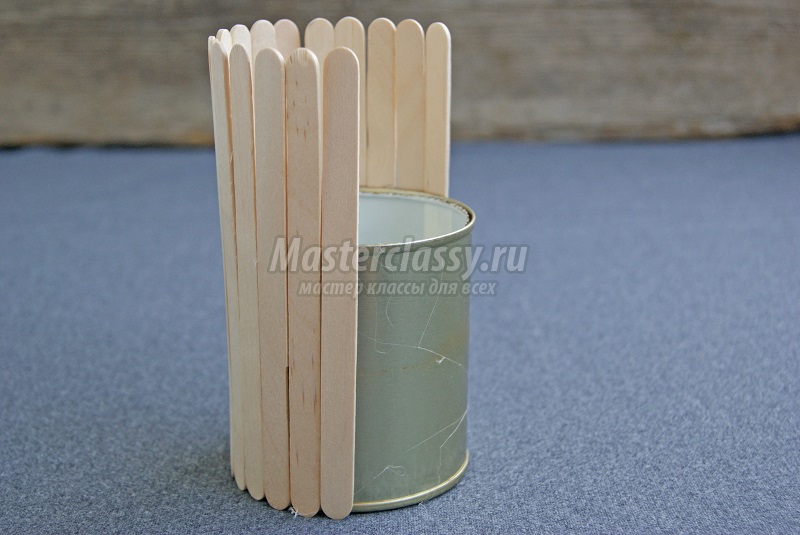
Thus, sticks plastered all we can.
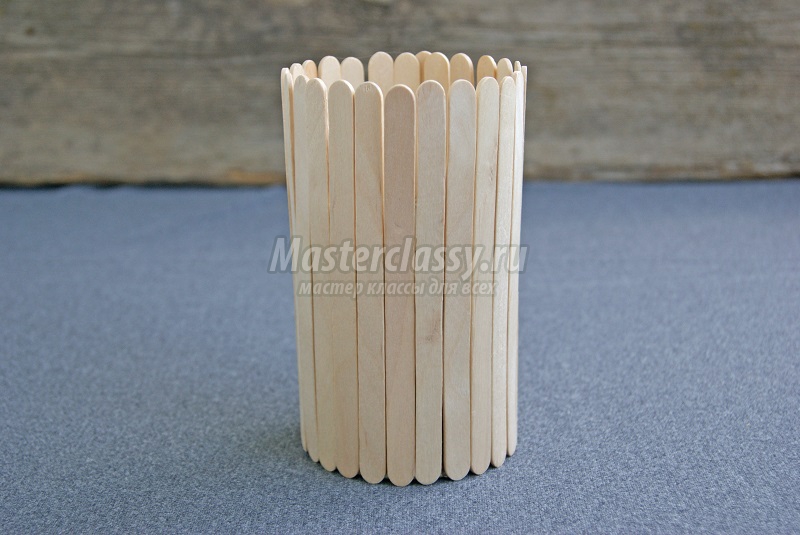
Since the bank we use, almost half below the height sticks, its inner part is almost not visible, so it does not have to decorate.
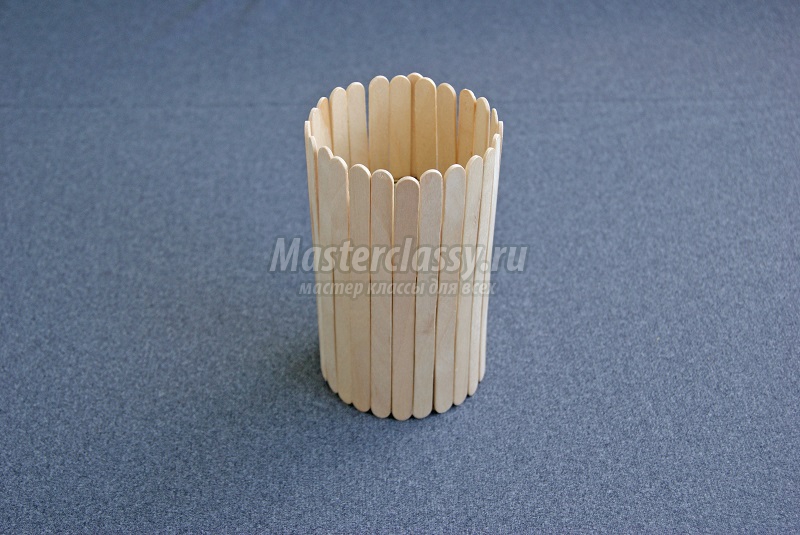
Further, all sticks painted blue acrylic paint. The paint dries quickly, covers well the wooden surface and after drying it does not stain your hands.
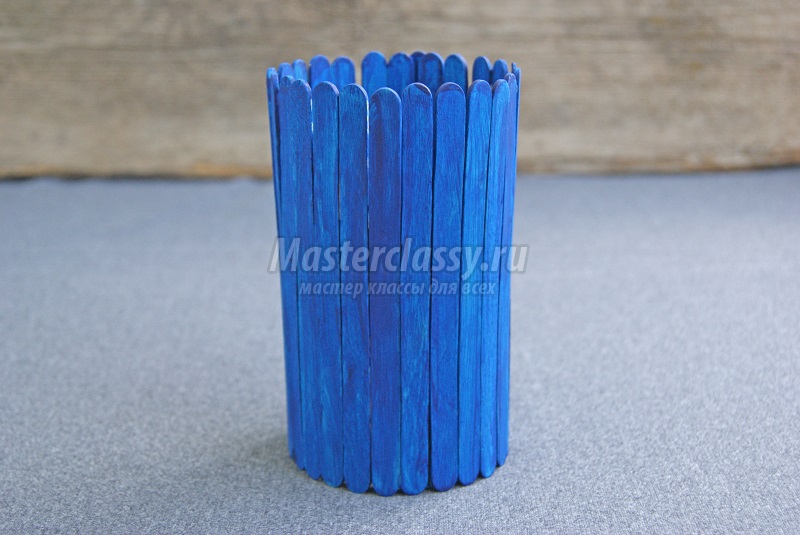
The next step was that we pasted jar at the top and bottom of the narrow rep ribbon. To do this, we have also used the glue gun.
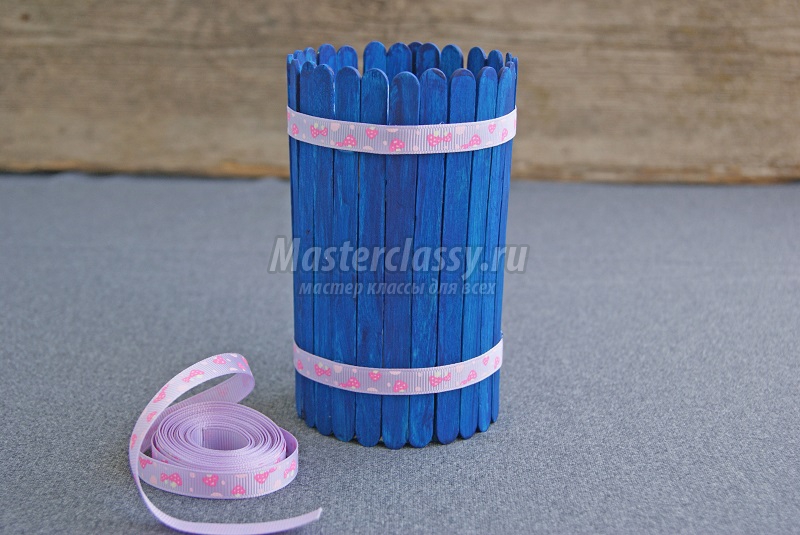
Decorating element has been decided to make a flower out of foam rubber. For this paper, we have drawn template-harvest and cut it.
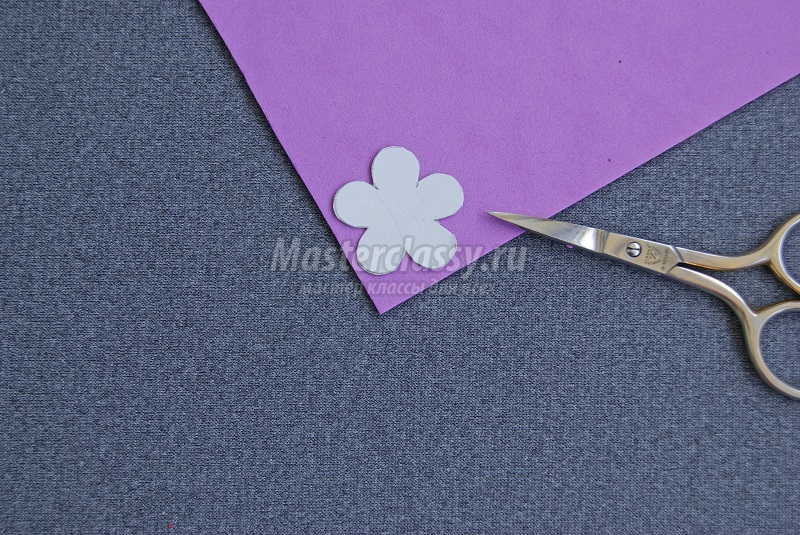
With a paper flower to a sheet of foam rubber, the sharp end of the scissors we circled outline. On a soft rubber surface was a clear trail that is easy to cut out the desired shape us.
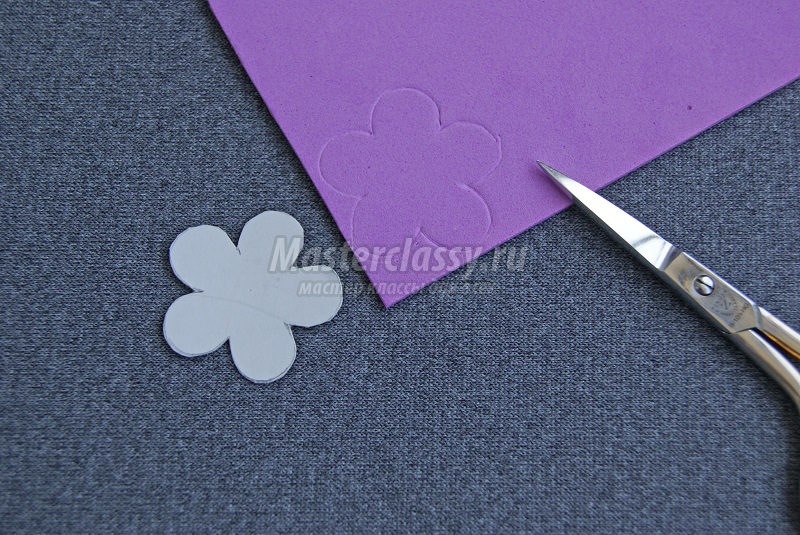
According to this principle, we have prepared a sufficient number of flowers.
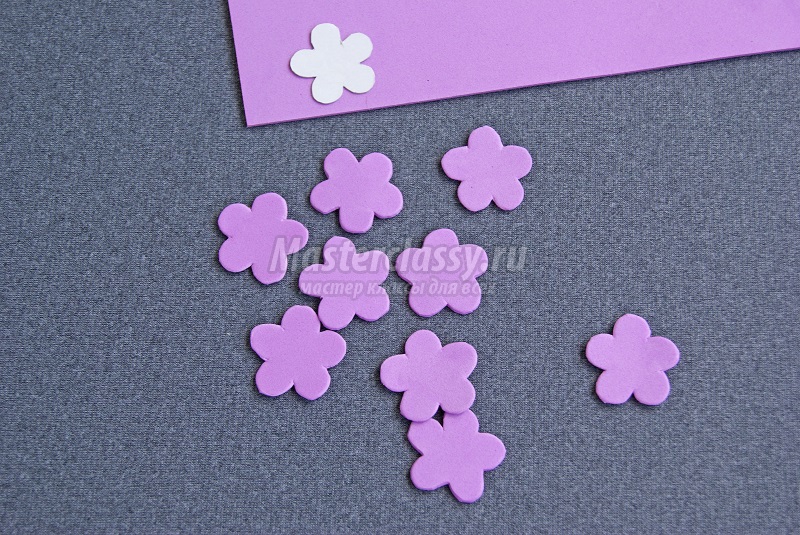
With hot melt glued to the wooden surface florets banks.

The middle of the flowers issued by gluing pink.
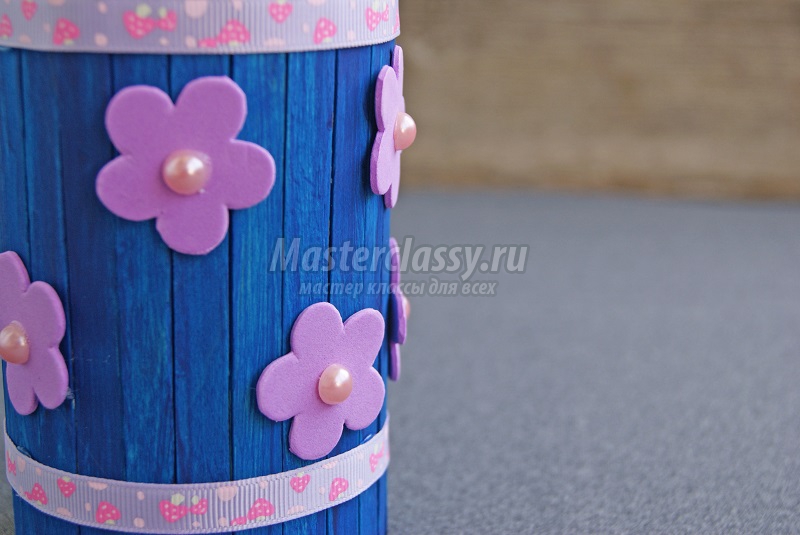
Once all the glue dries, the jar is ready for use. From it came out very nice pencil holders. Try it and you make the decor tin cans with their own hands and finally get an exclusive little thing desired.


courtesy: masterclassy
25+ Latest Bridal Henna Mehndi Designs
Outstanding Bridal Mehndi Designs For Your Wedding Day:


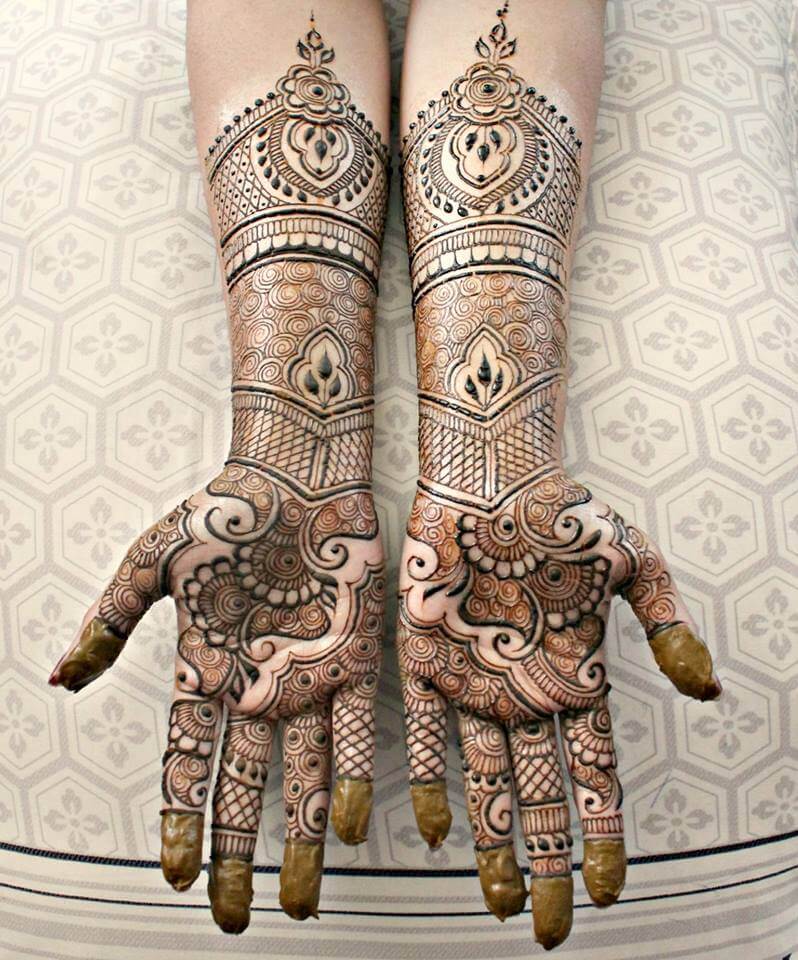
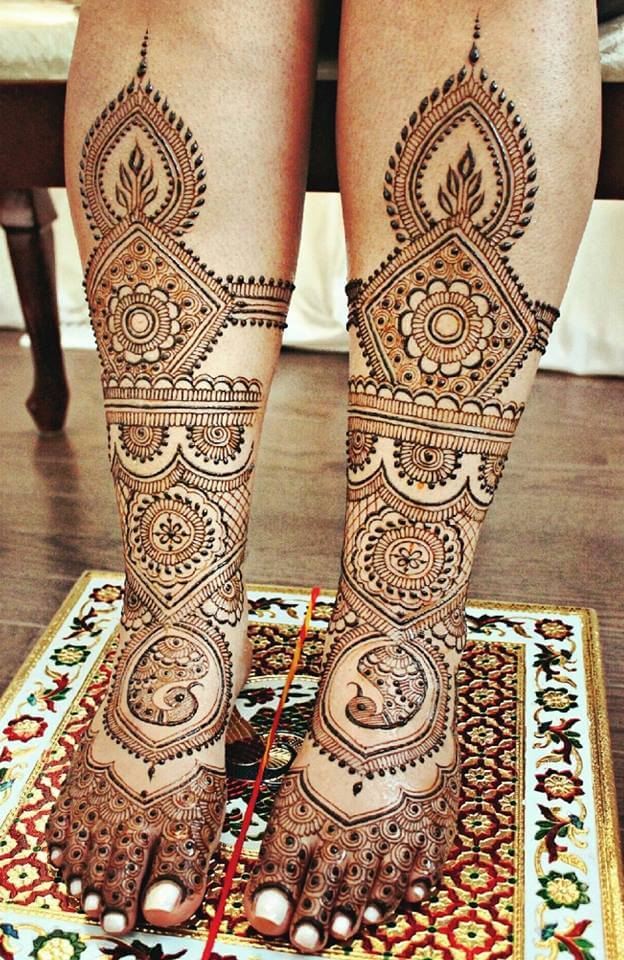
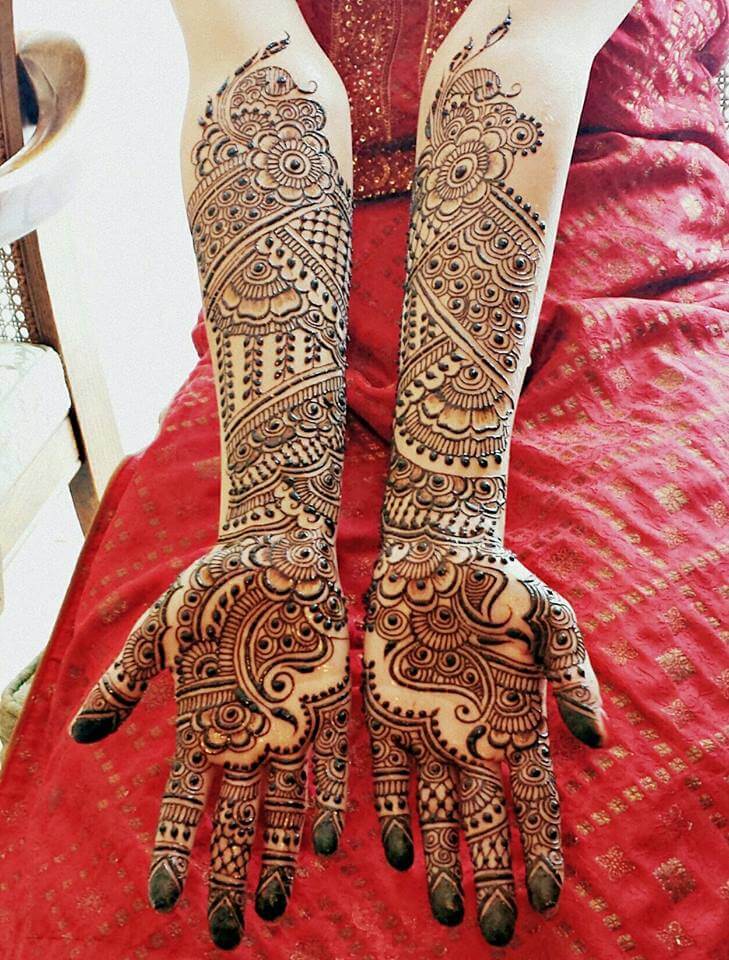

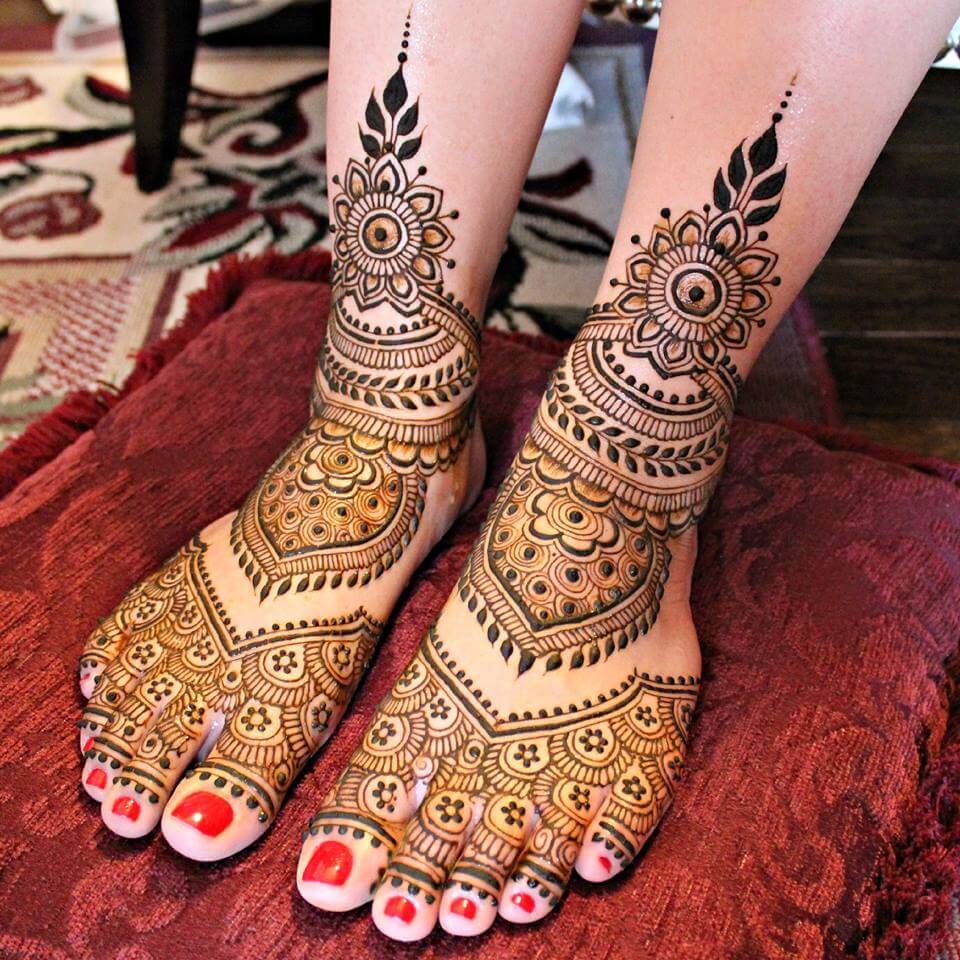

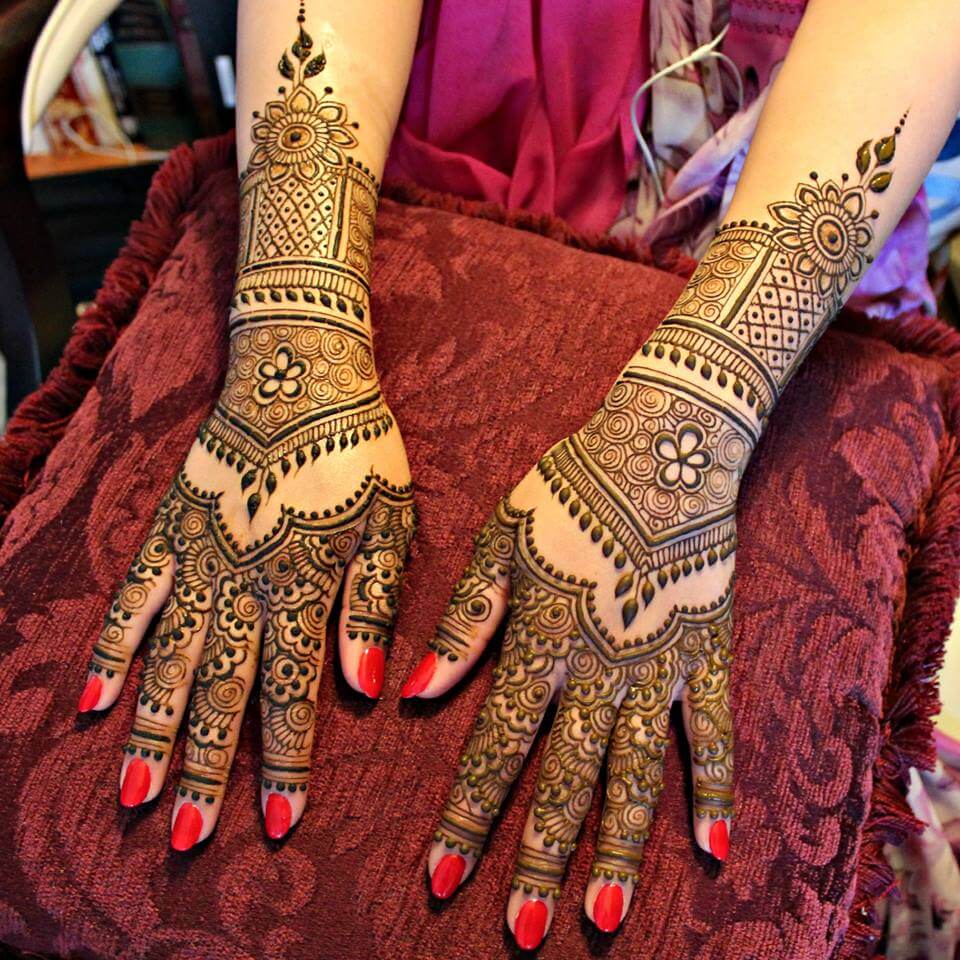

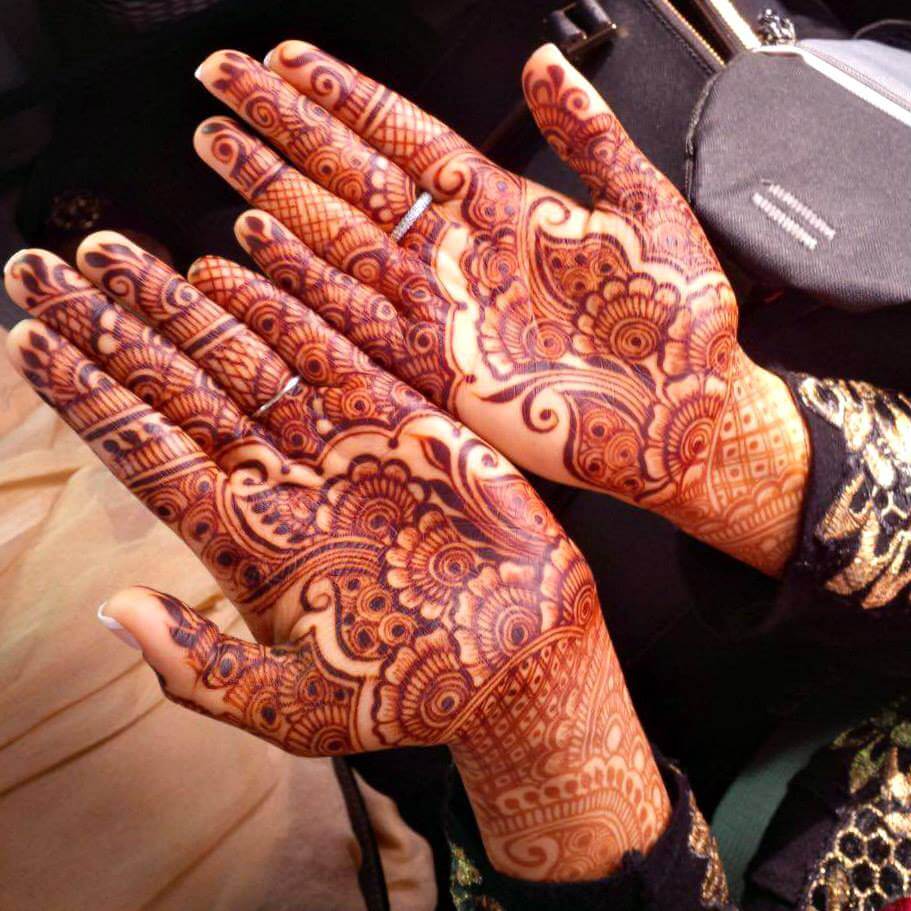

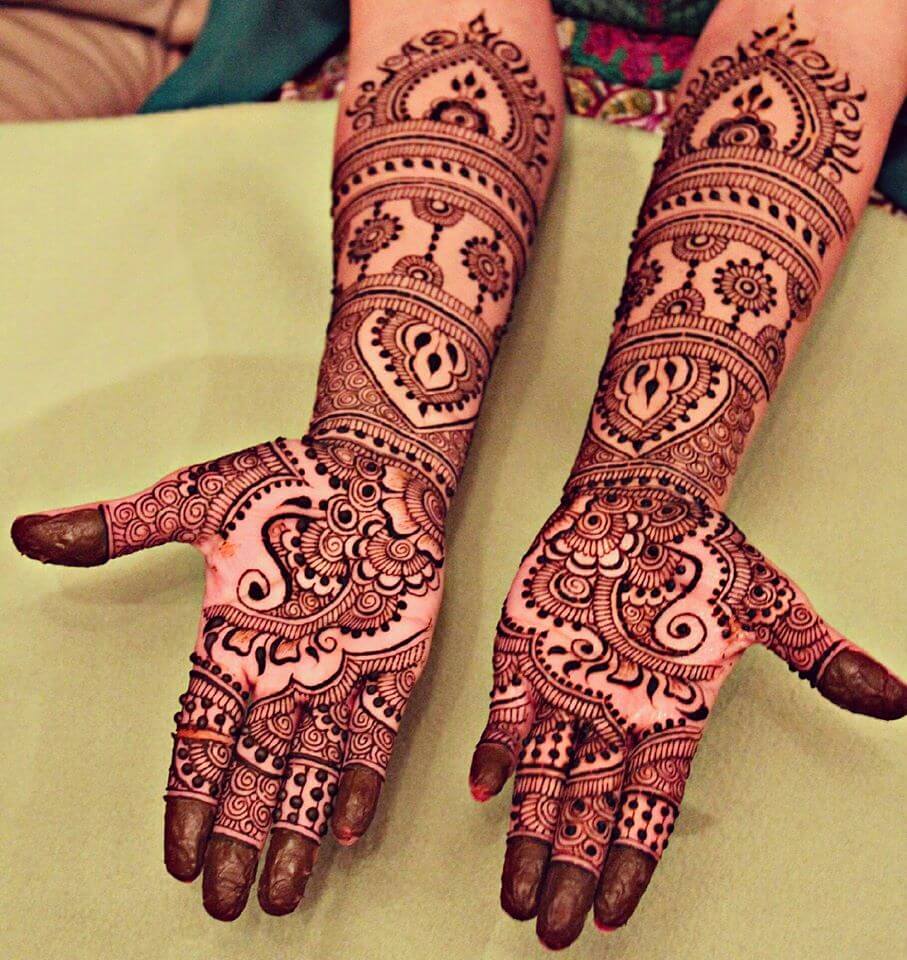

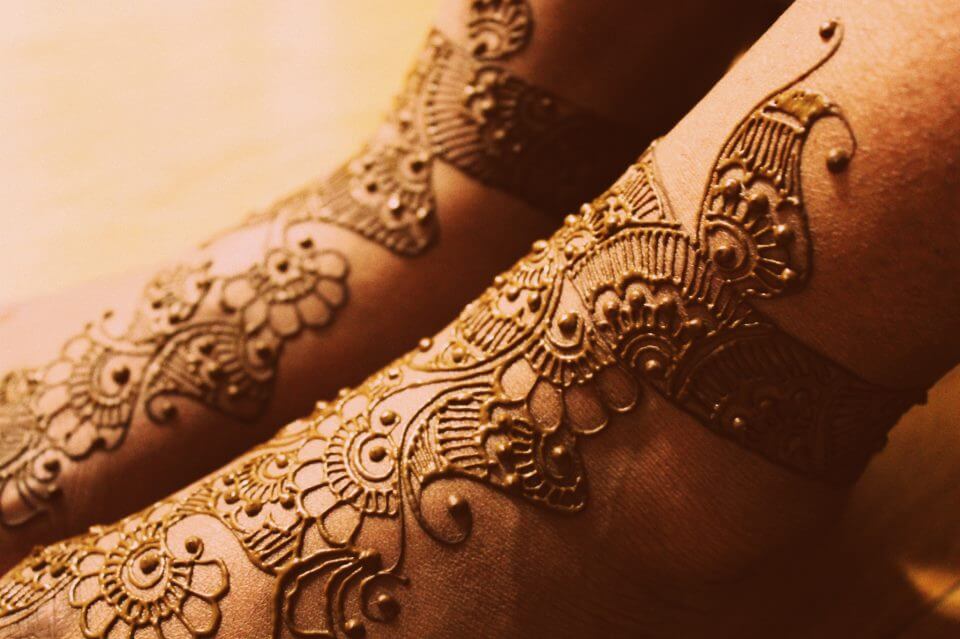
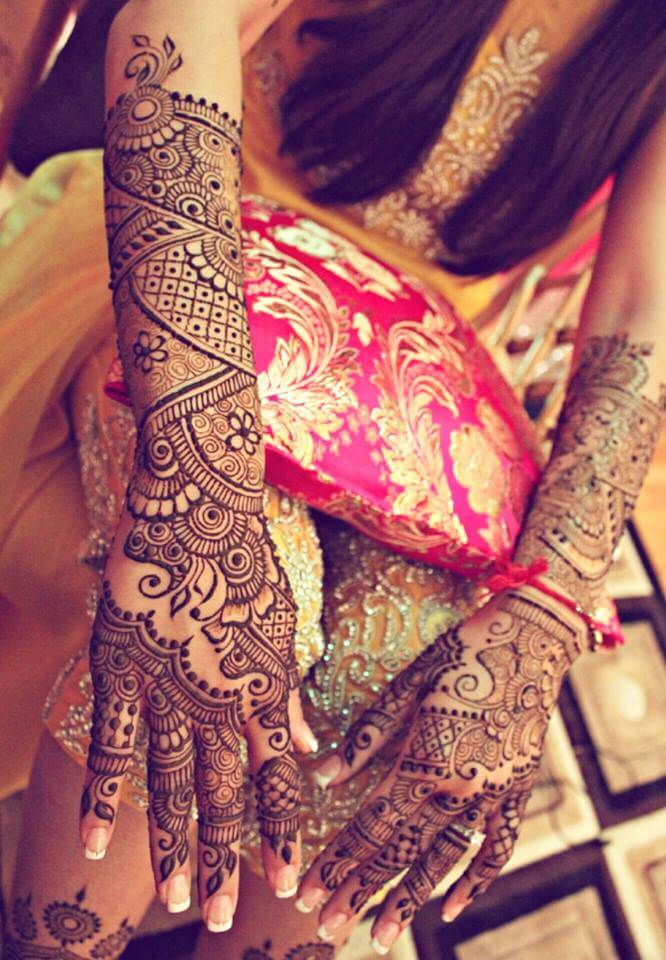

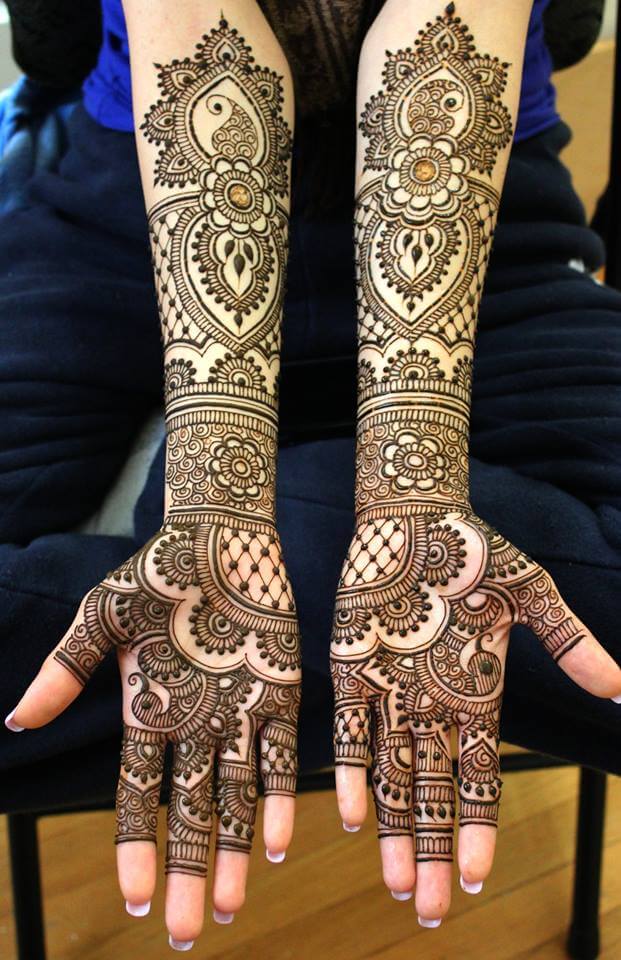
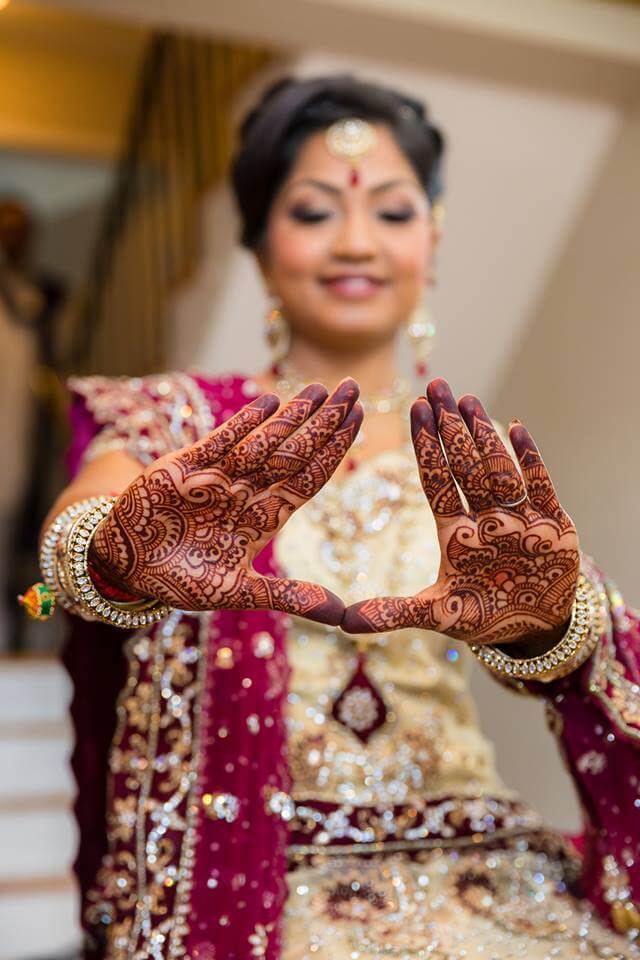


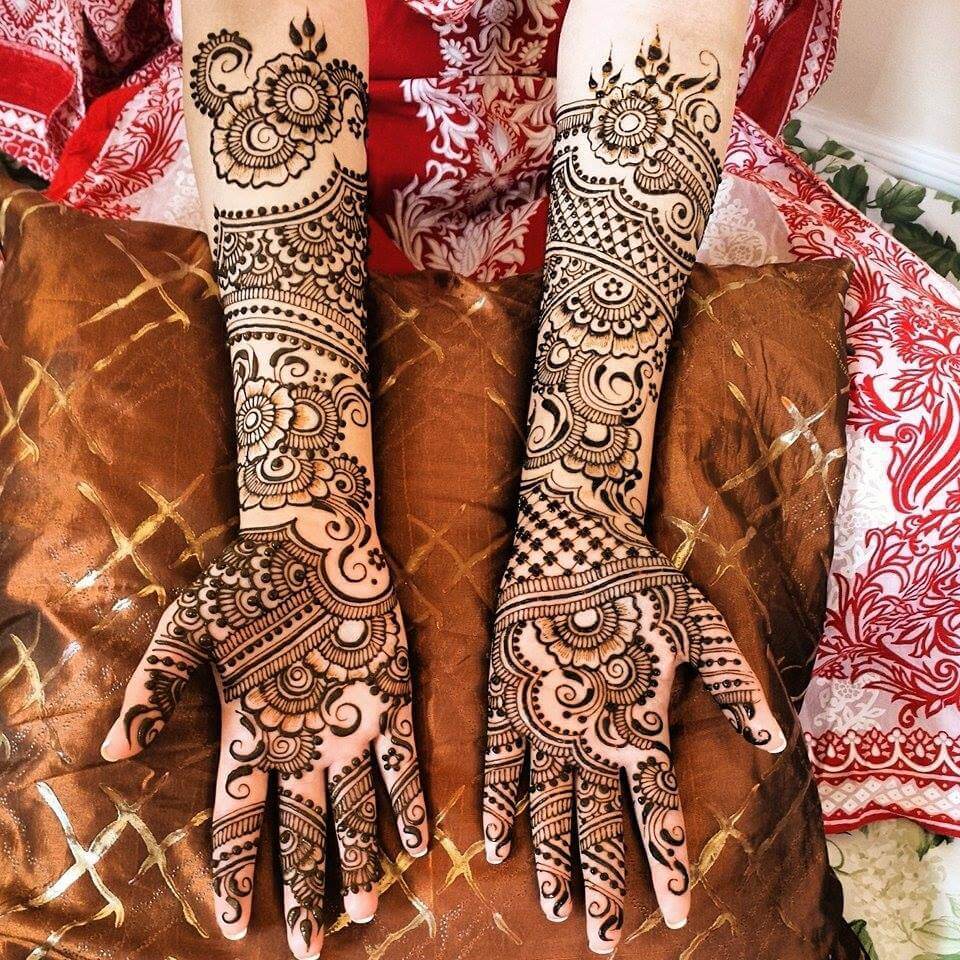

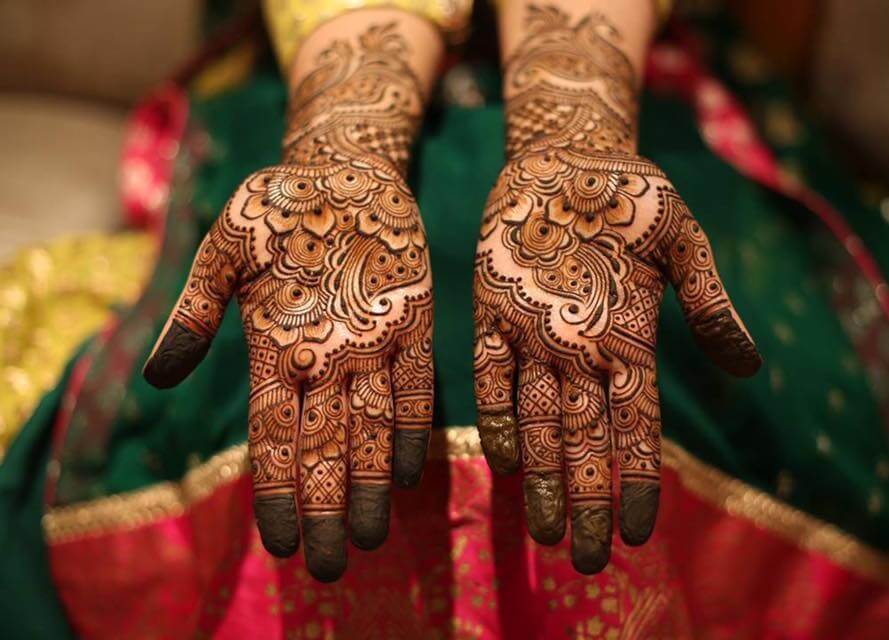
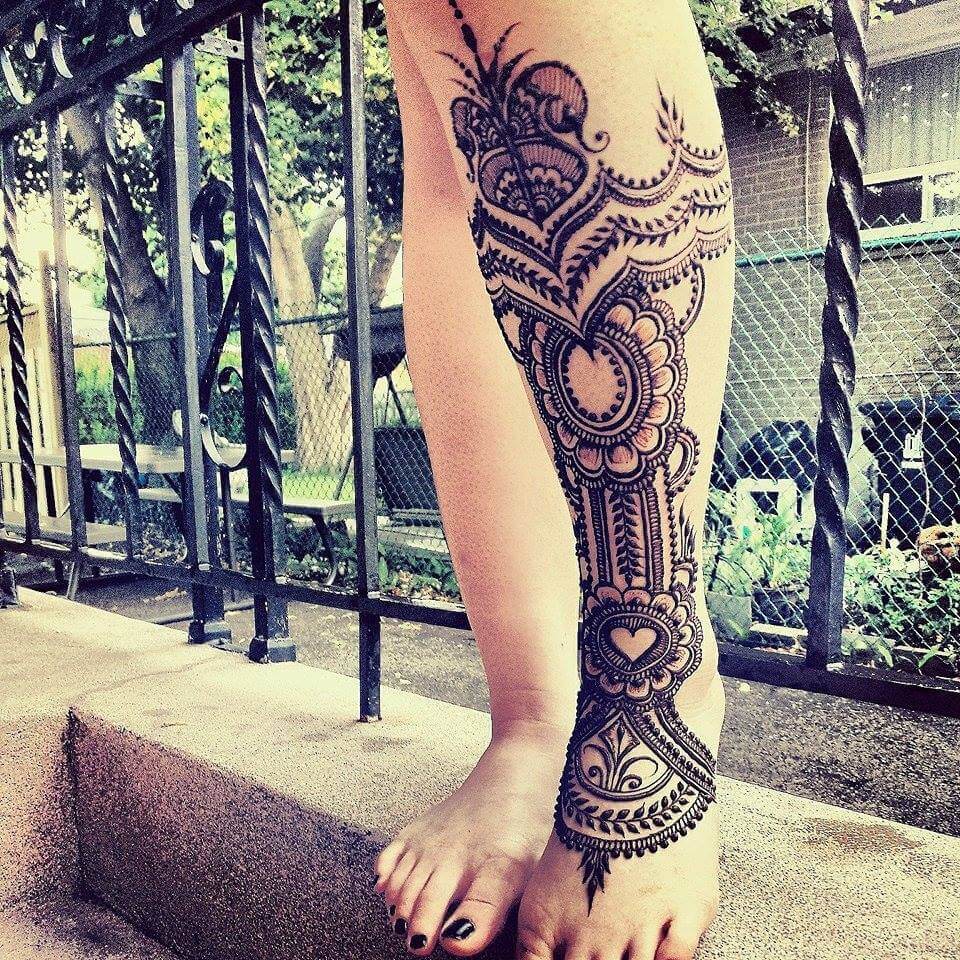
Best Arabic Mehndi Designs Collection for Girls
Stylish & Trendy Arabic Mehndi Designs Collection for Hands:

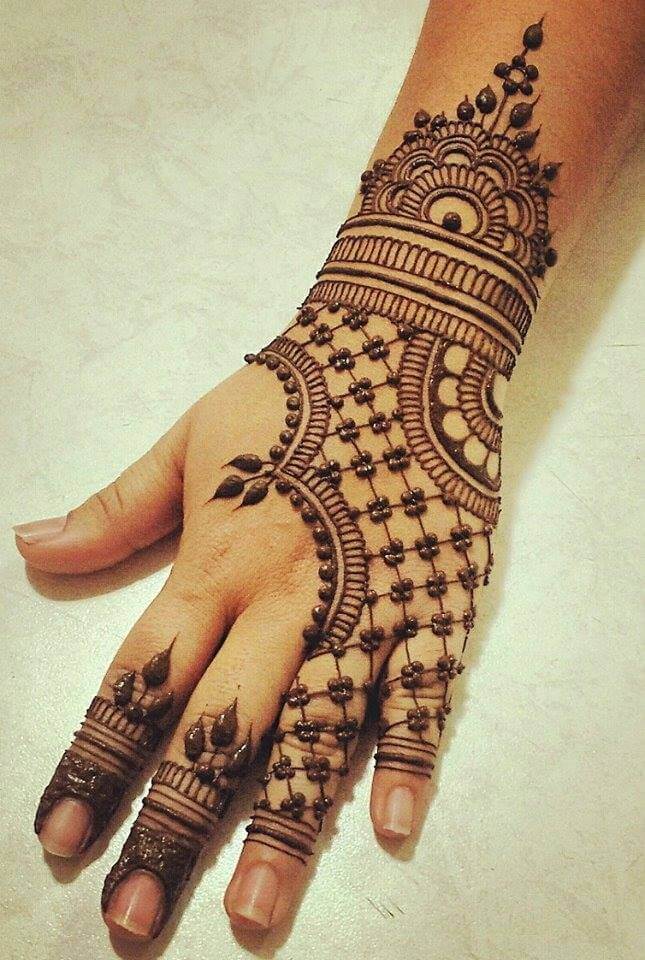


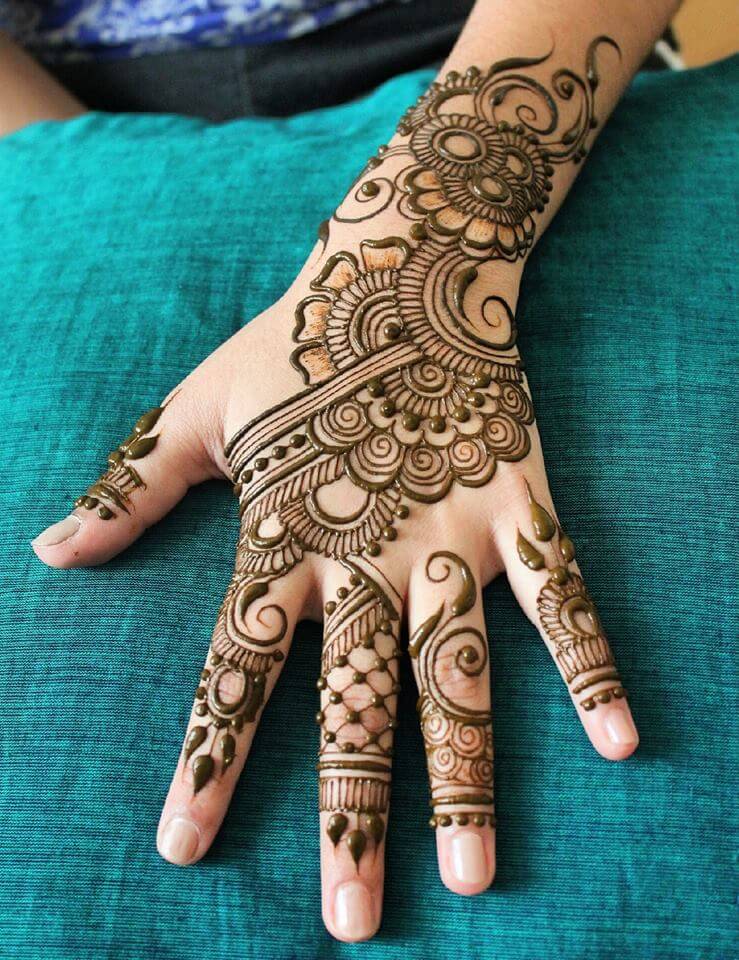

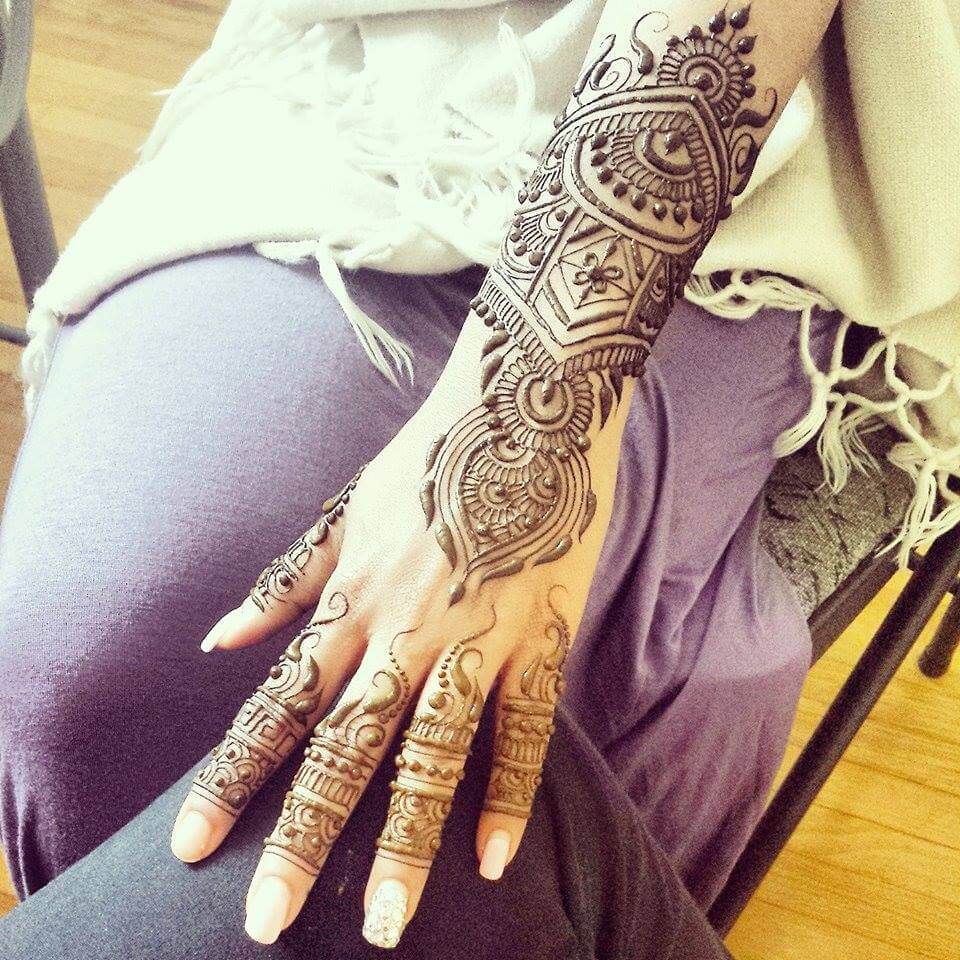
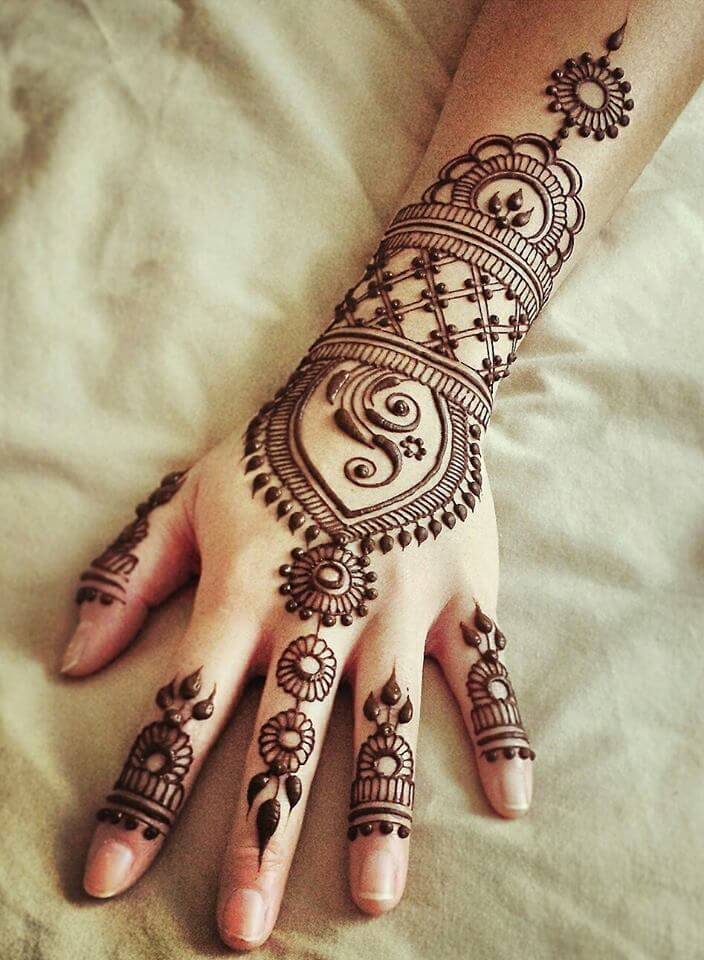
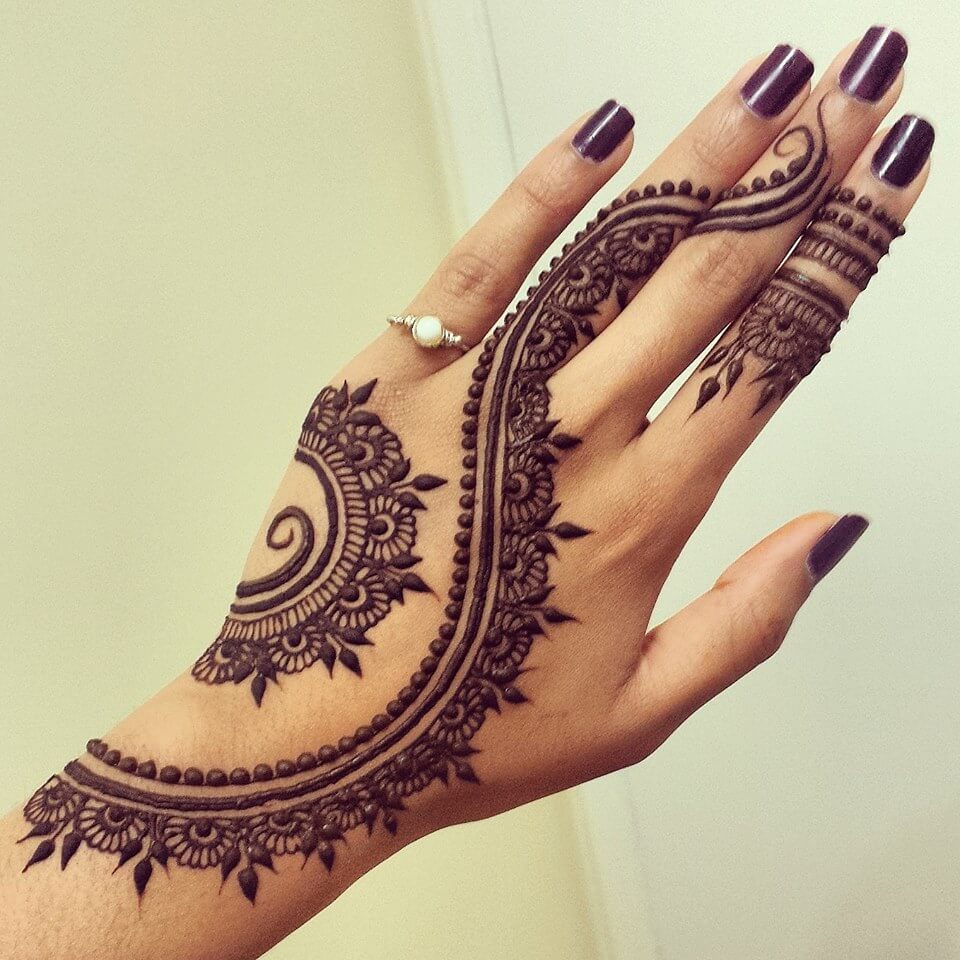



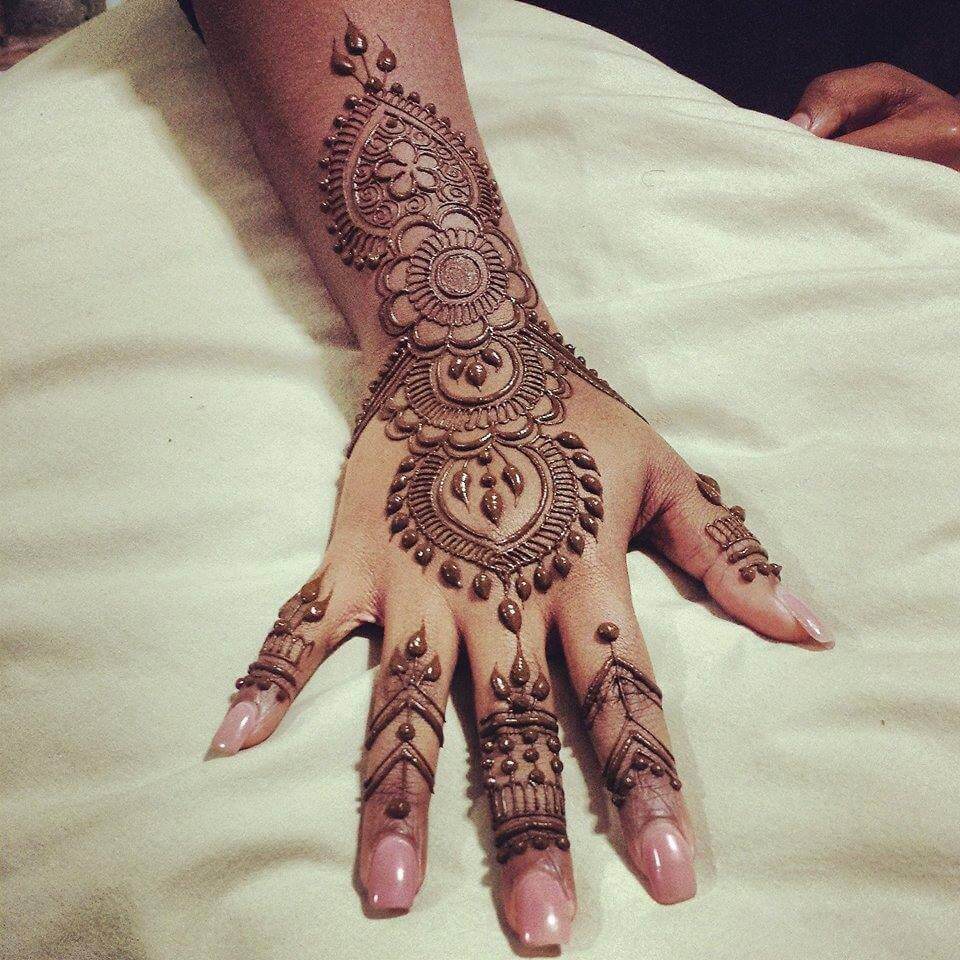
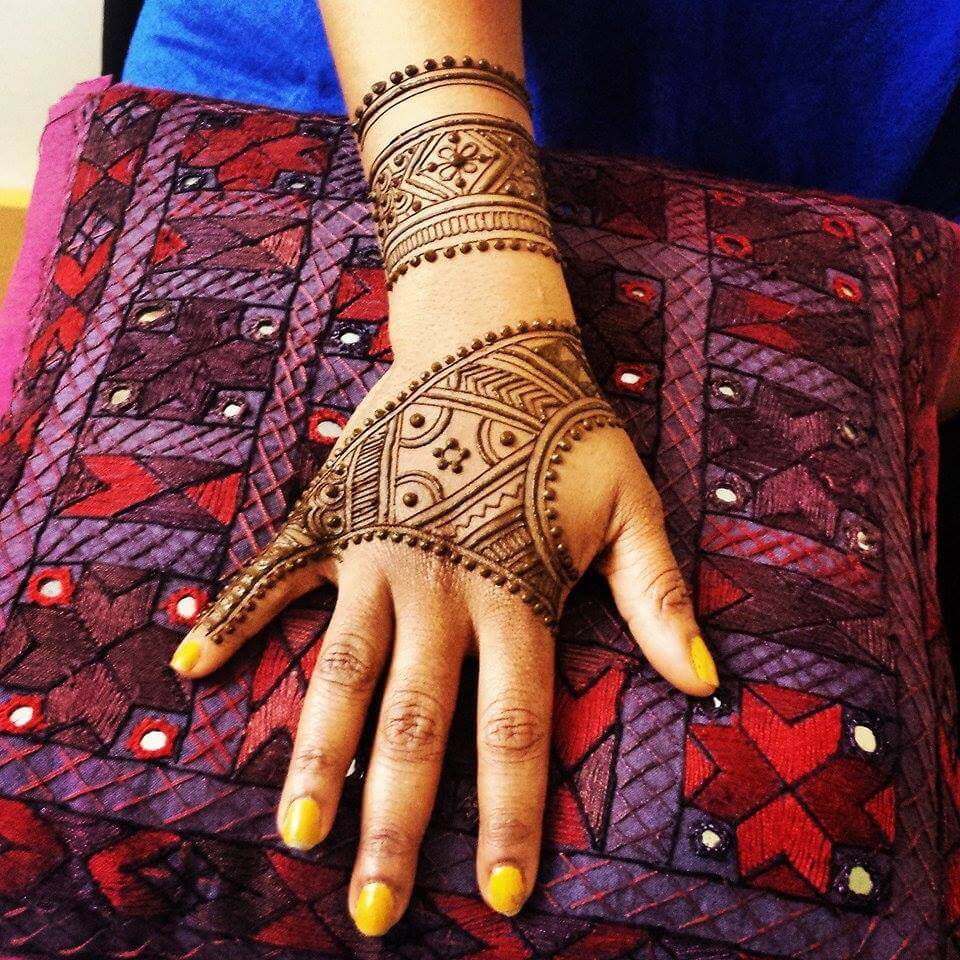
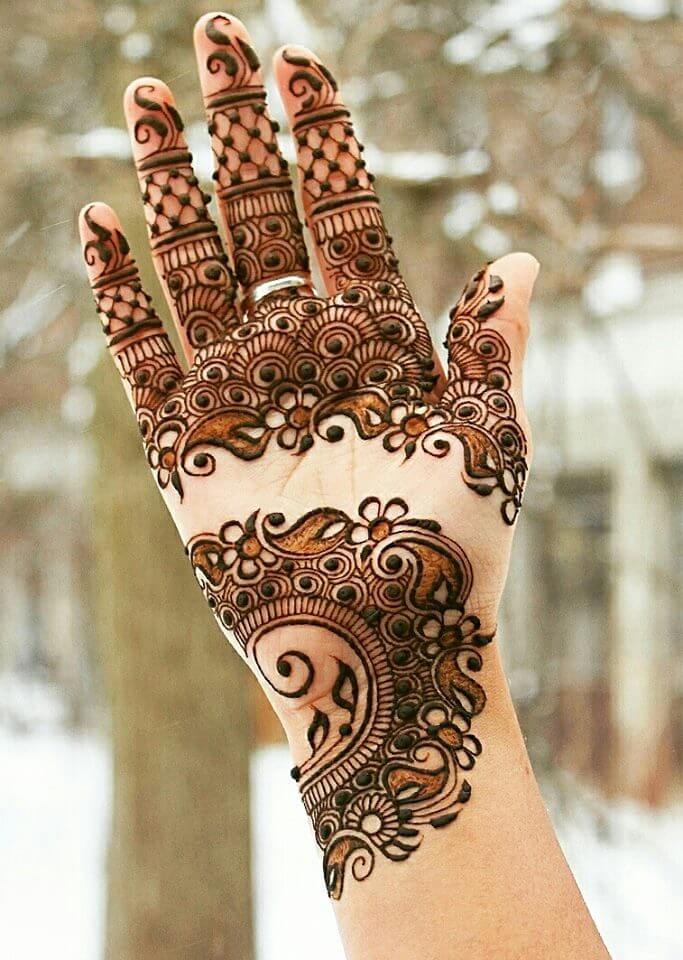
DIY Felt Baby Booties Easy Pattern (Tutorial)
I saw the tiny toes of my newest nephew, i wanted to make him some booties. Without knowing how to crochet or knit, i went with my favorite medium: felt. i winged it with the pattern, but i’m pretty happy with how they turned out! tiny shoes are just the cutest.
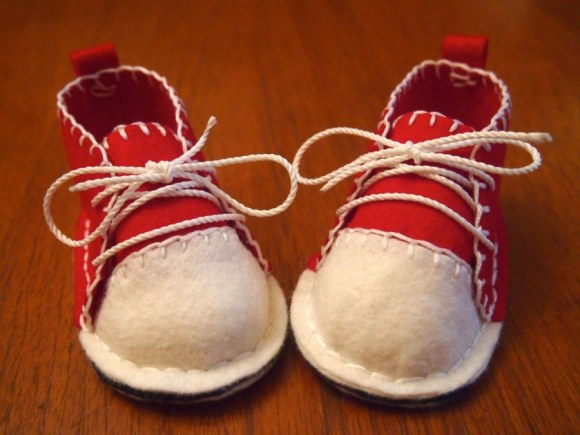
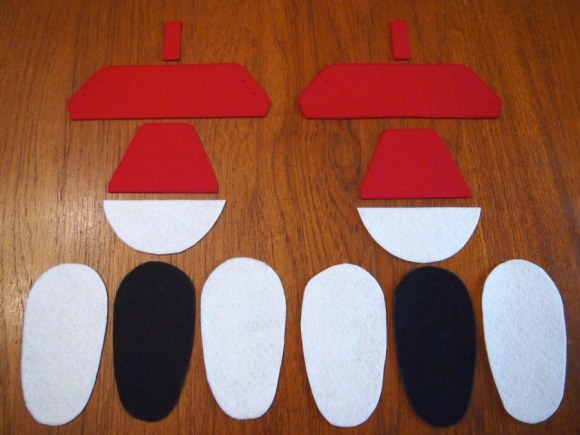
Required Materials:
- 1 sheet colored felt
- 1 sheet white felt
- 1 sheet black felt
- white embroidery floss
- 40″ of white cord, cut in half

- cut out pieces according to pattern.
- punch holes for lacing (i used a leather punch)
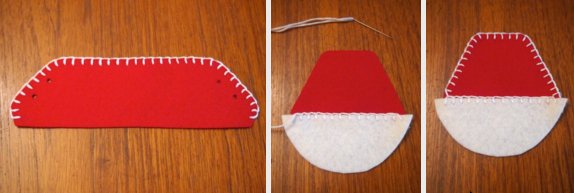
- blanket stitch the sides and top edge of back panels.
- overlap the toe cap 3/8″ from the edge of the tongue. blanket stitch pieces together.
- blanket stitch around the tongue
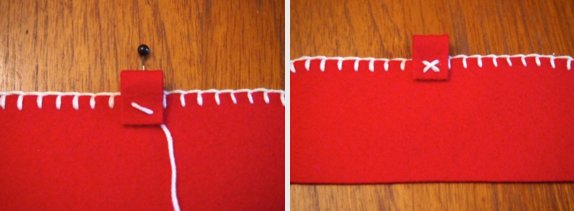
- mark the center back of back panel with a pin.
- fold the loops in half lengthwise and stitch to center back, using an X.

- sandwich all 3 layers of the sole together. use pins to mark where toe cap placement.
- baste around the toe cap, 1/8″ from the edge.
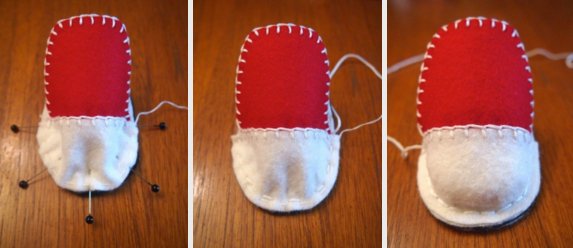
- gather basting stitches and pin to the sole, lining up with markings
- stitch toe cap to sole, going through all layers.
- once around the toe cap, reverse stitch back through all layers.
- remove basting stitches. fill toe with tissue and press the seam allowance so it lays flat.

- pin center back of back panel to center back of sole.
- starting where the toe cap ends, stitch sides and back panel to the sole, going through all layers.
- when you reach the toe cap on the other side, reverse stitch back through to the beginning.
- lace up and slip in your tiny toes!
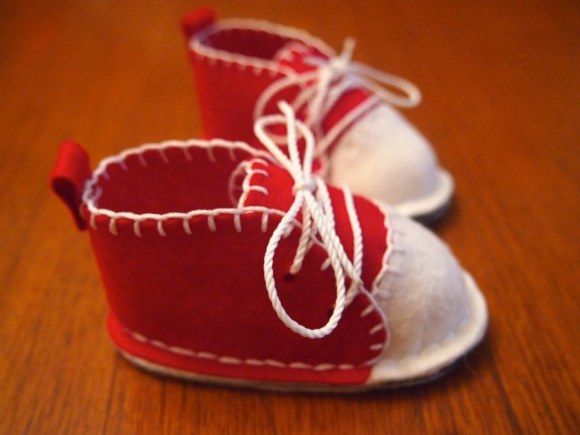
Hope you like this tutorial.
Source: whatido.com
We would love to hear your thoughts in the comment section below. And be sure to like us Facebook for more ideas!
Thank you for visiting our website. Keep Creating with Art & Craft!
